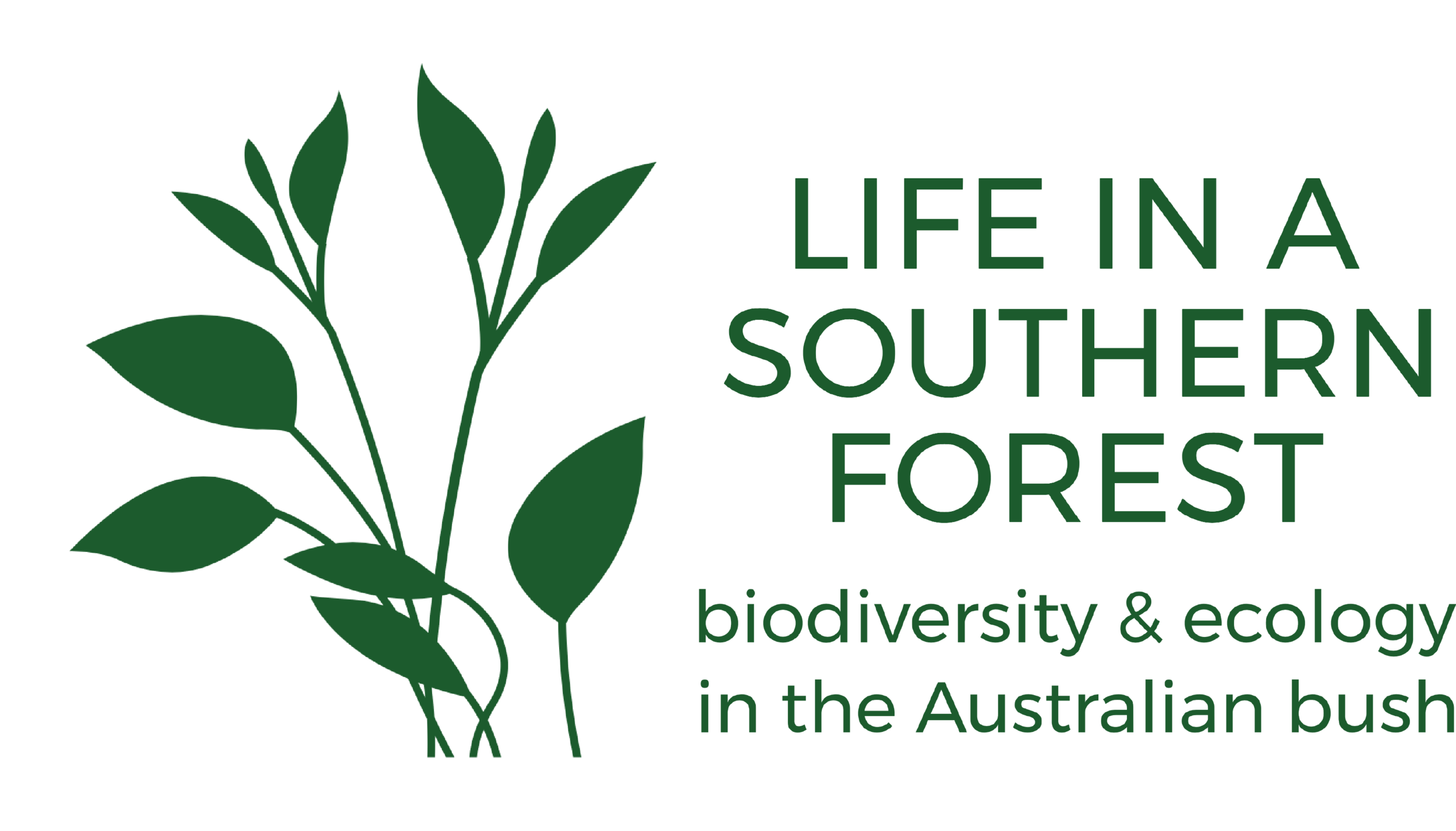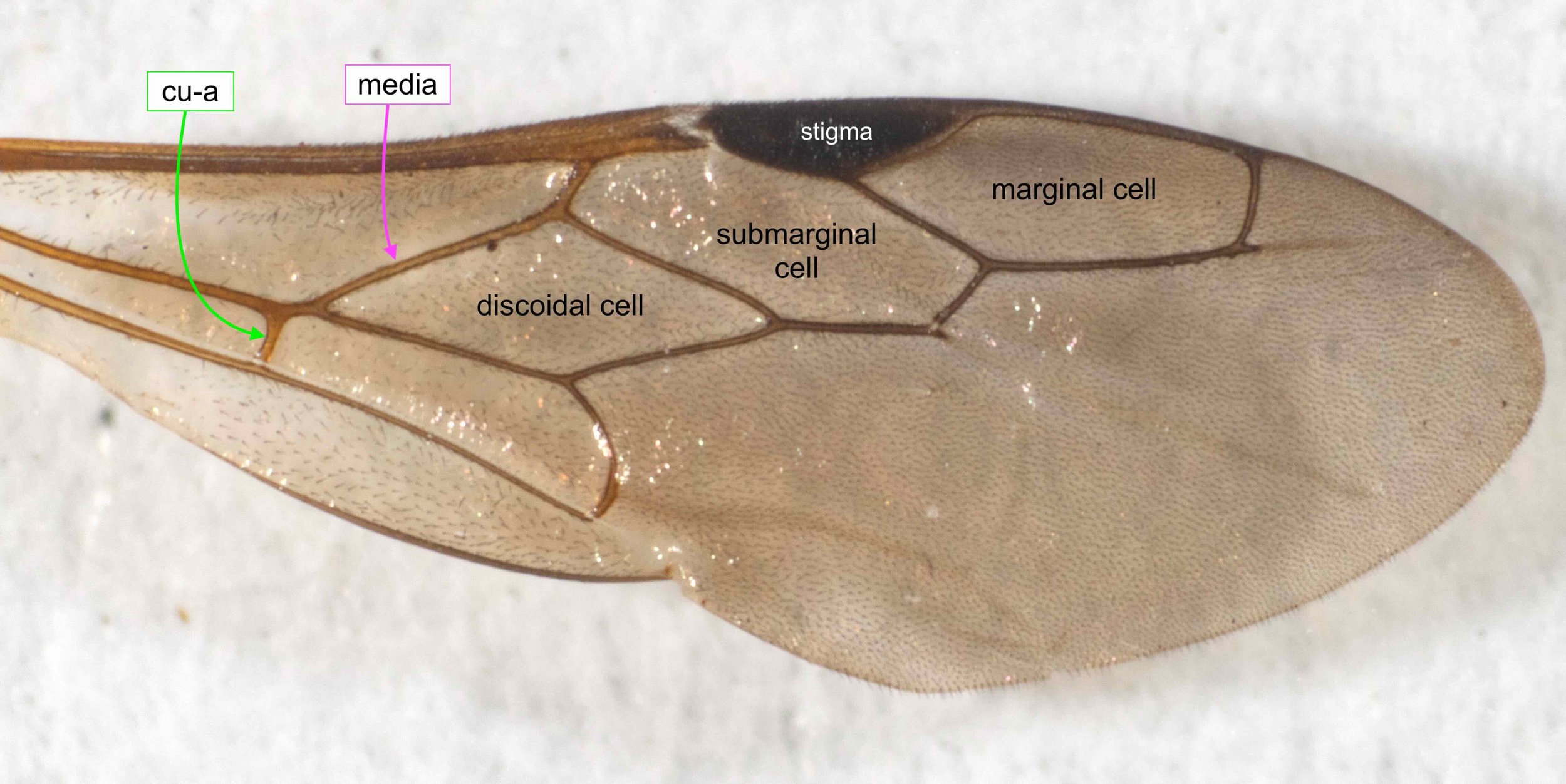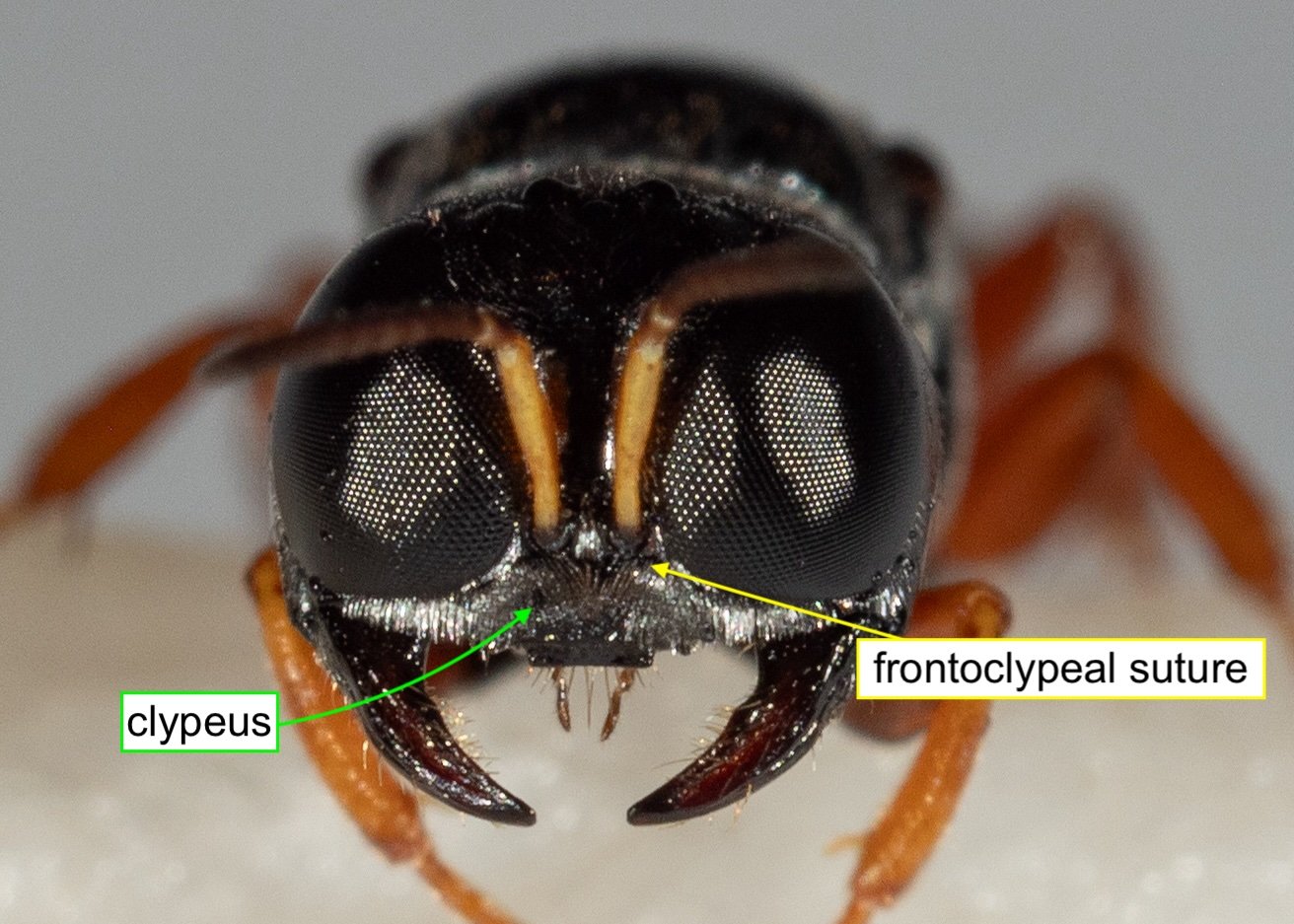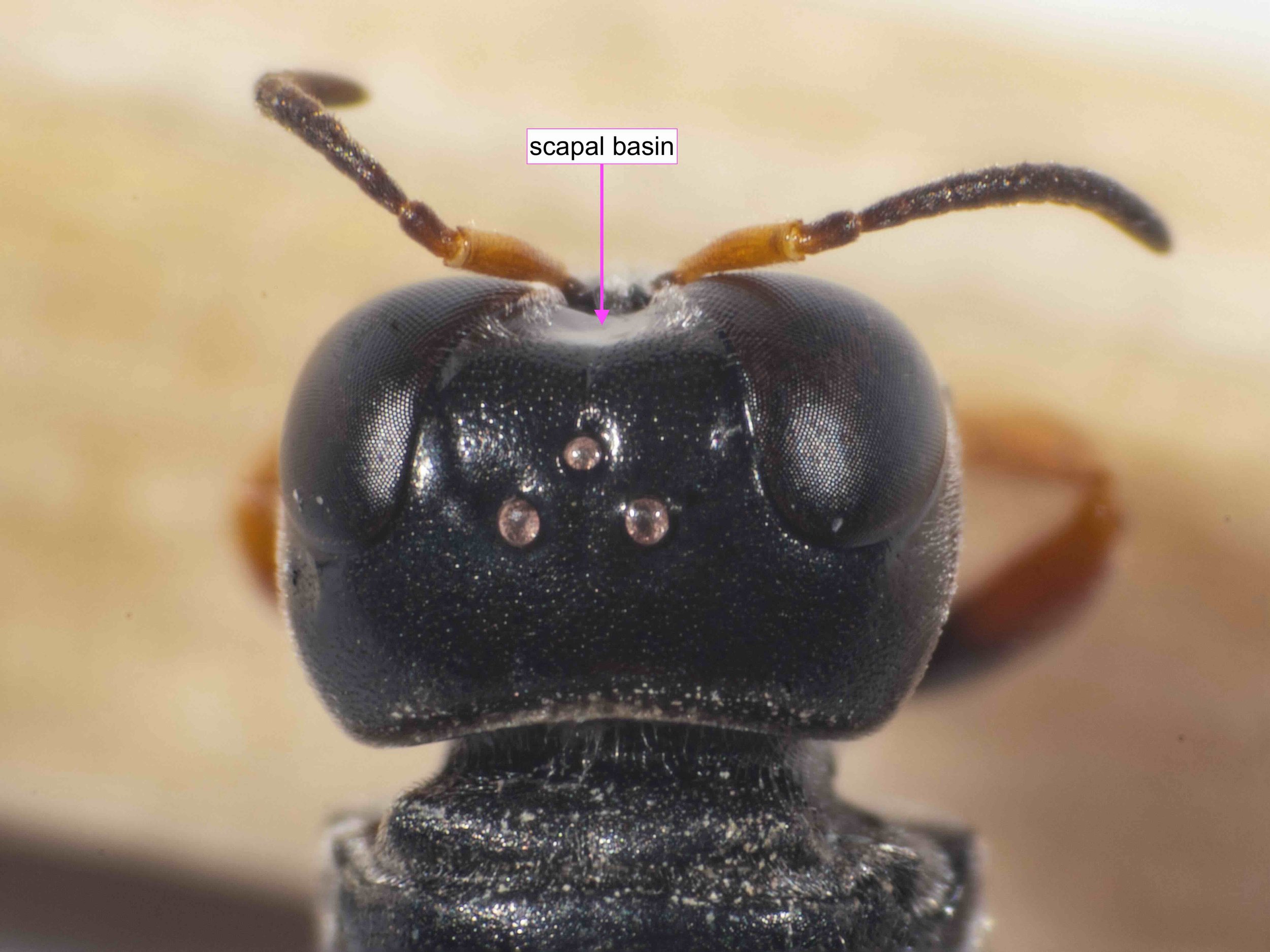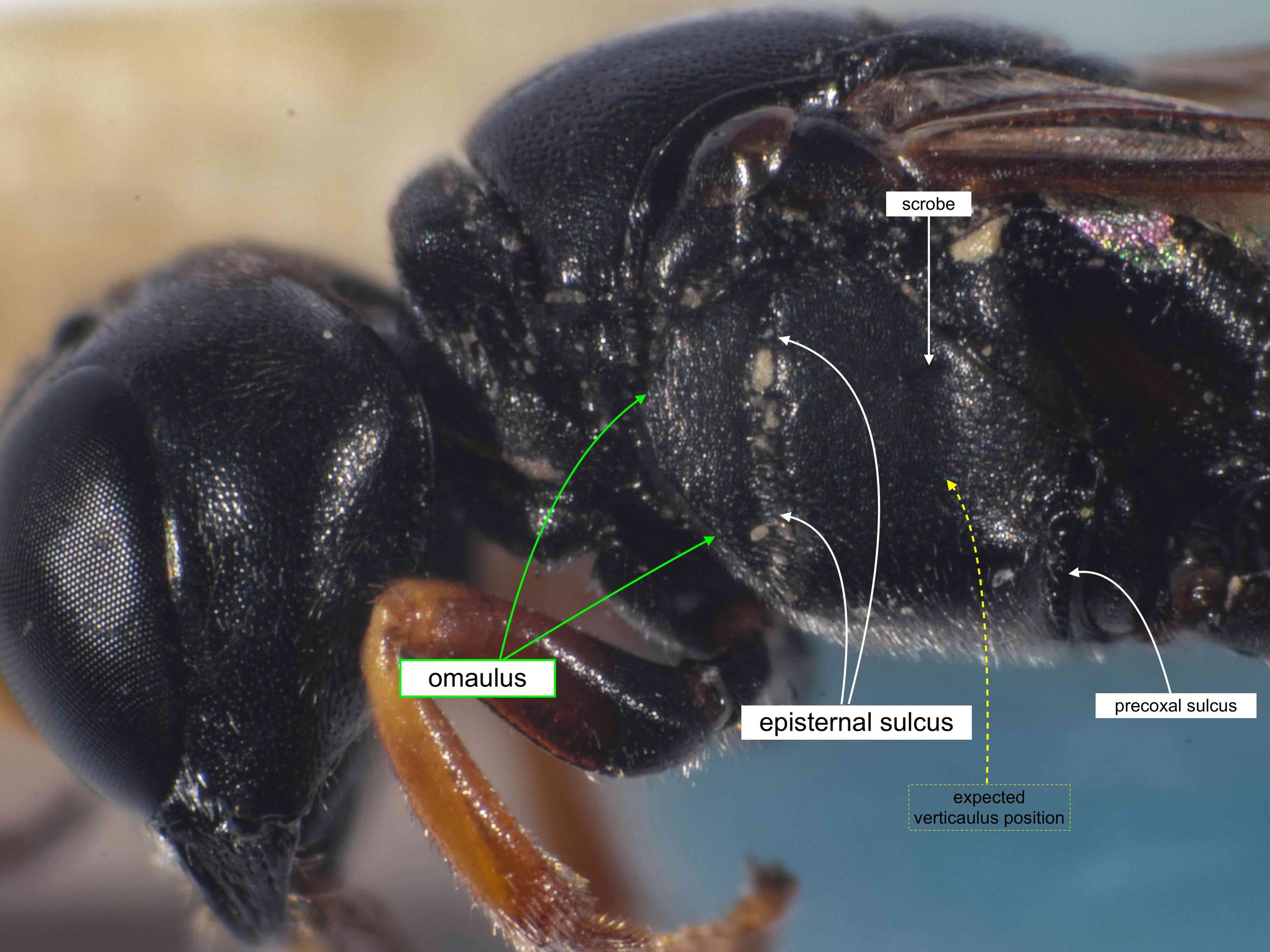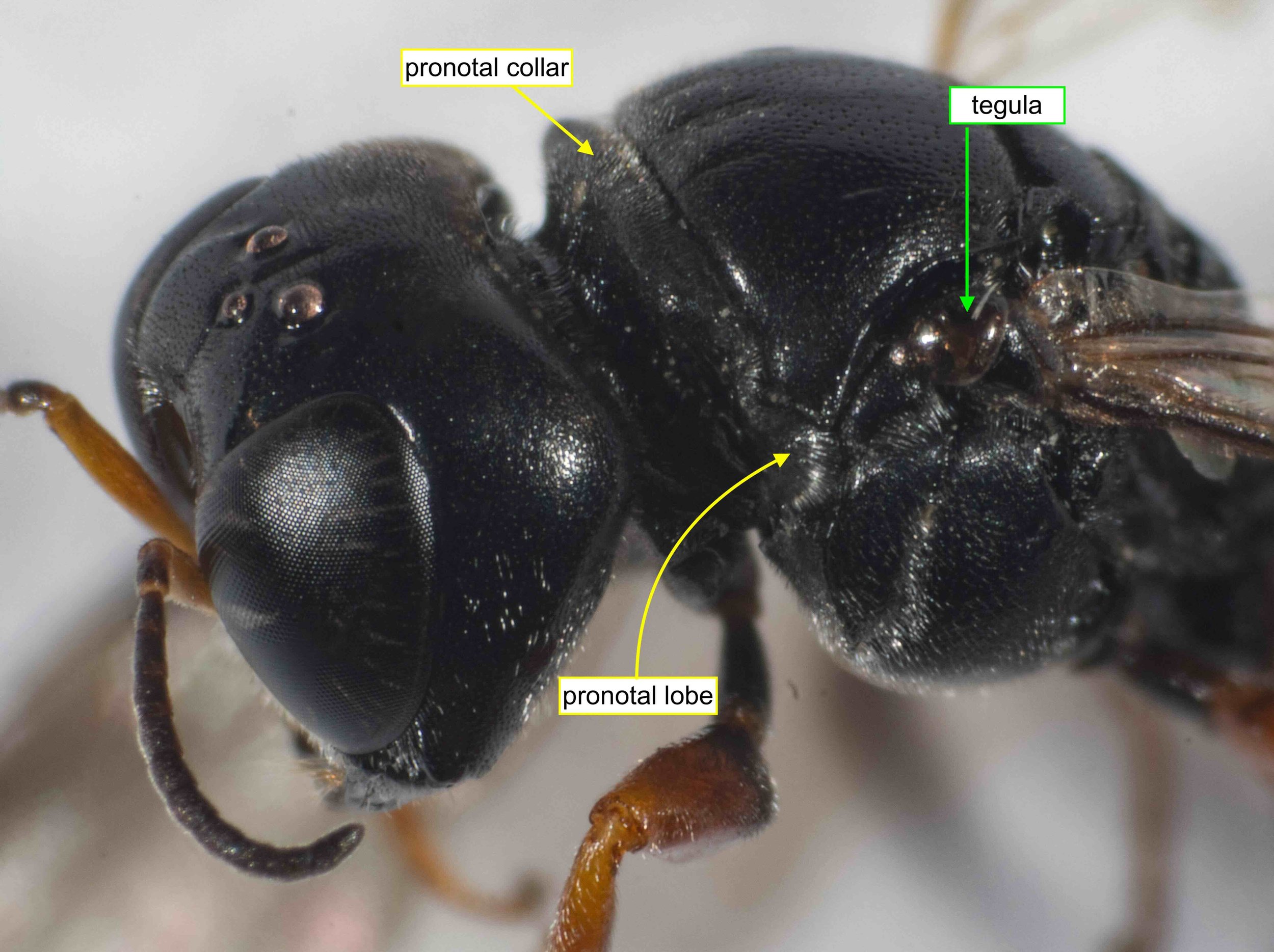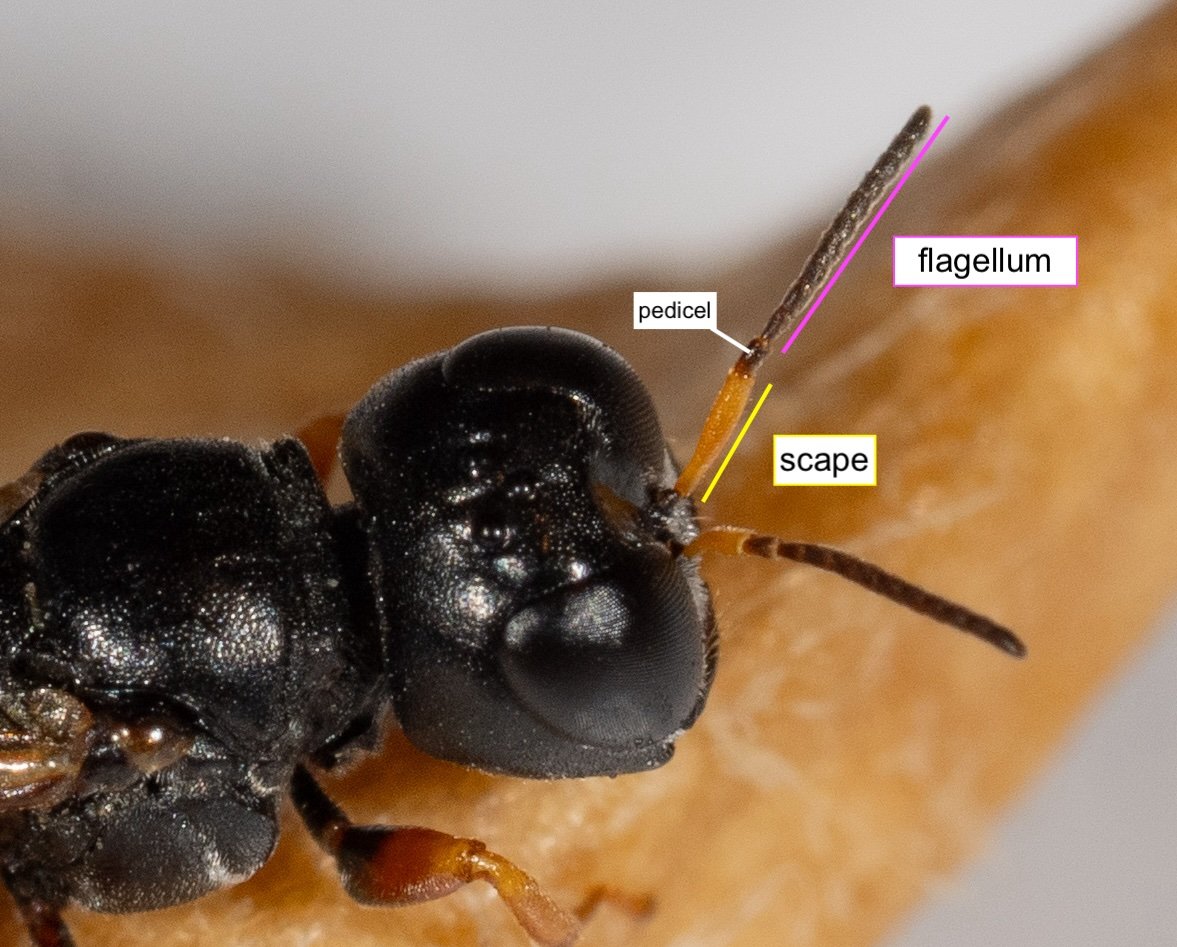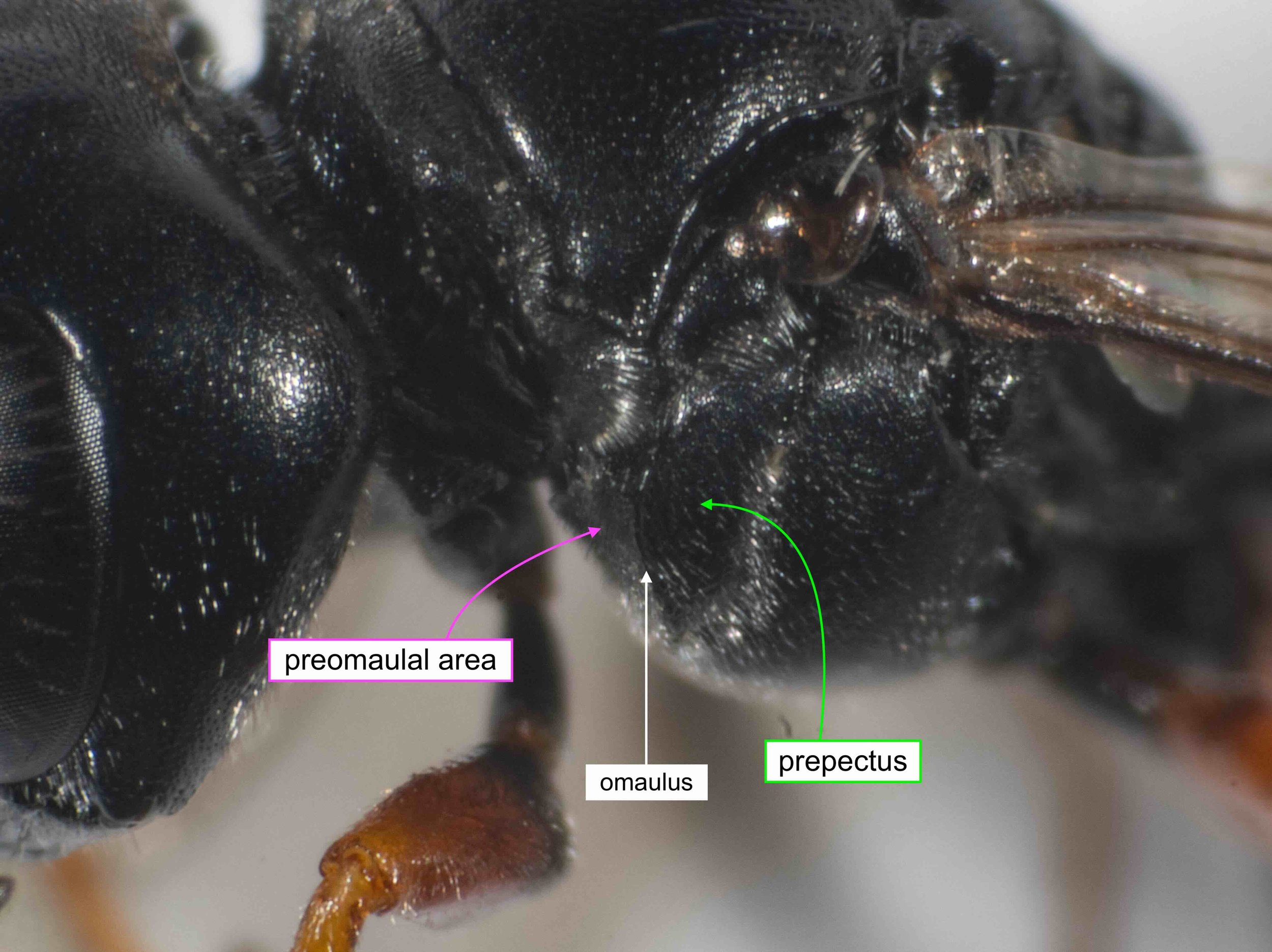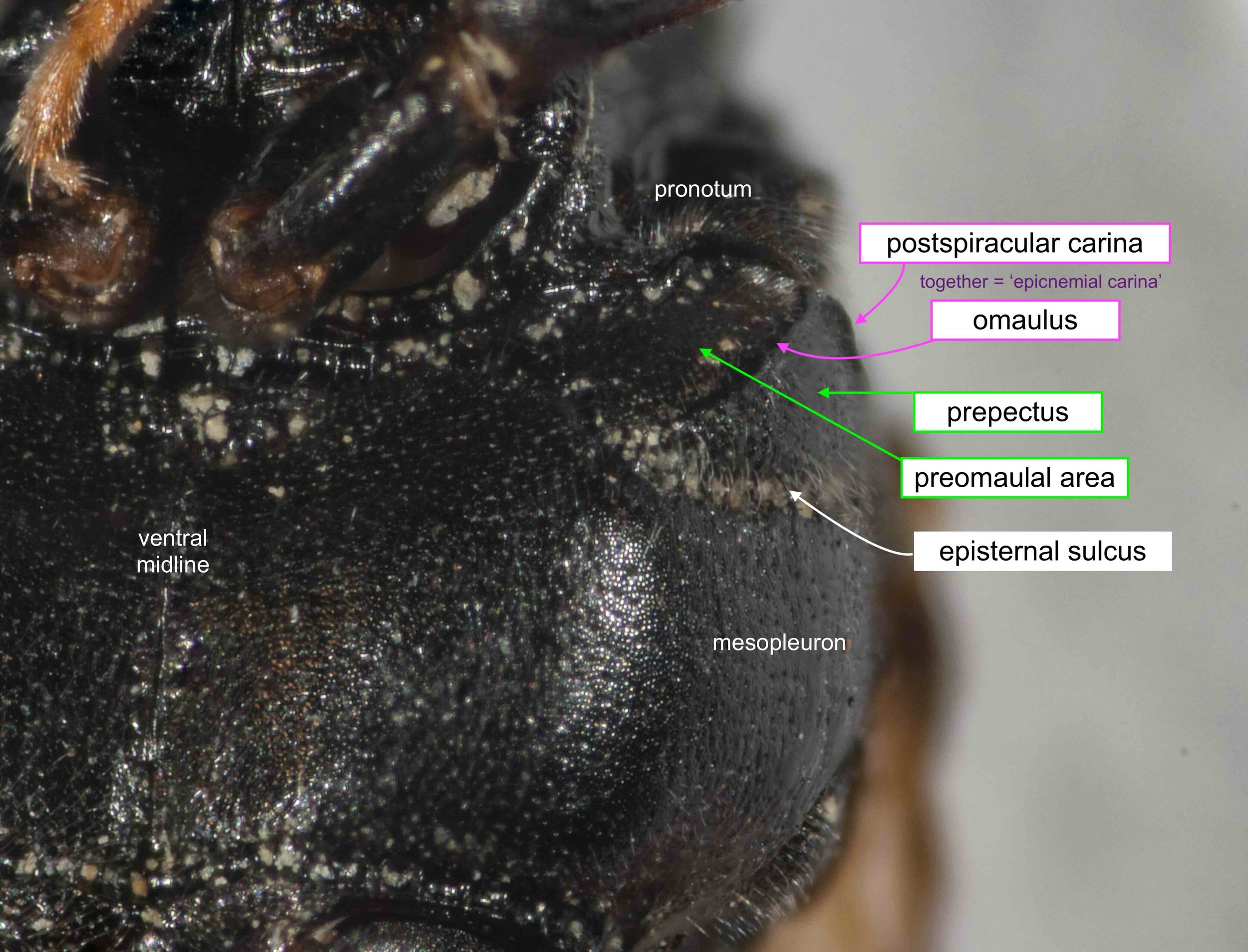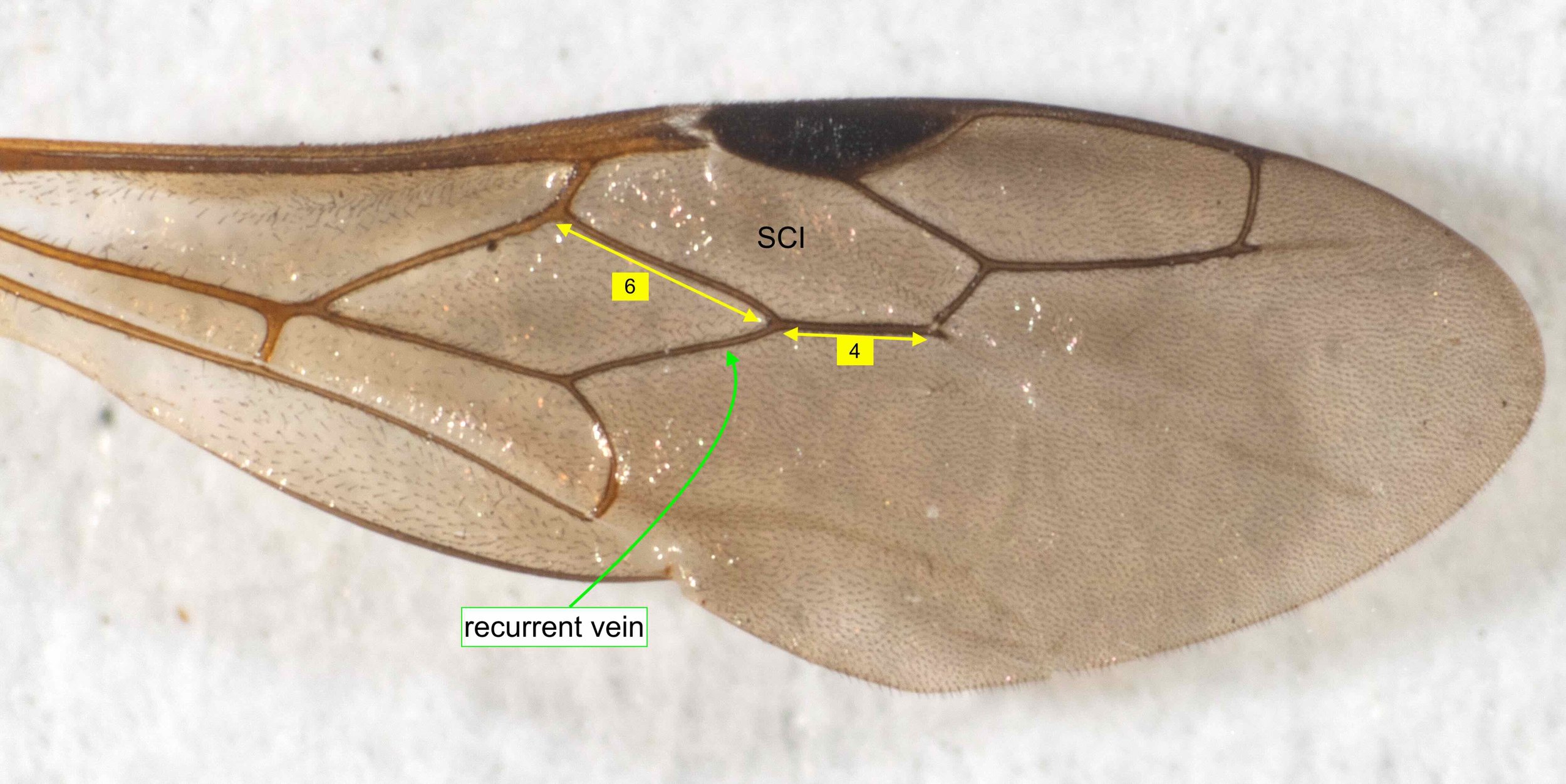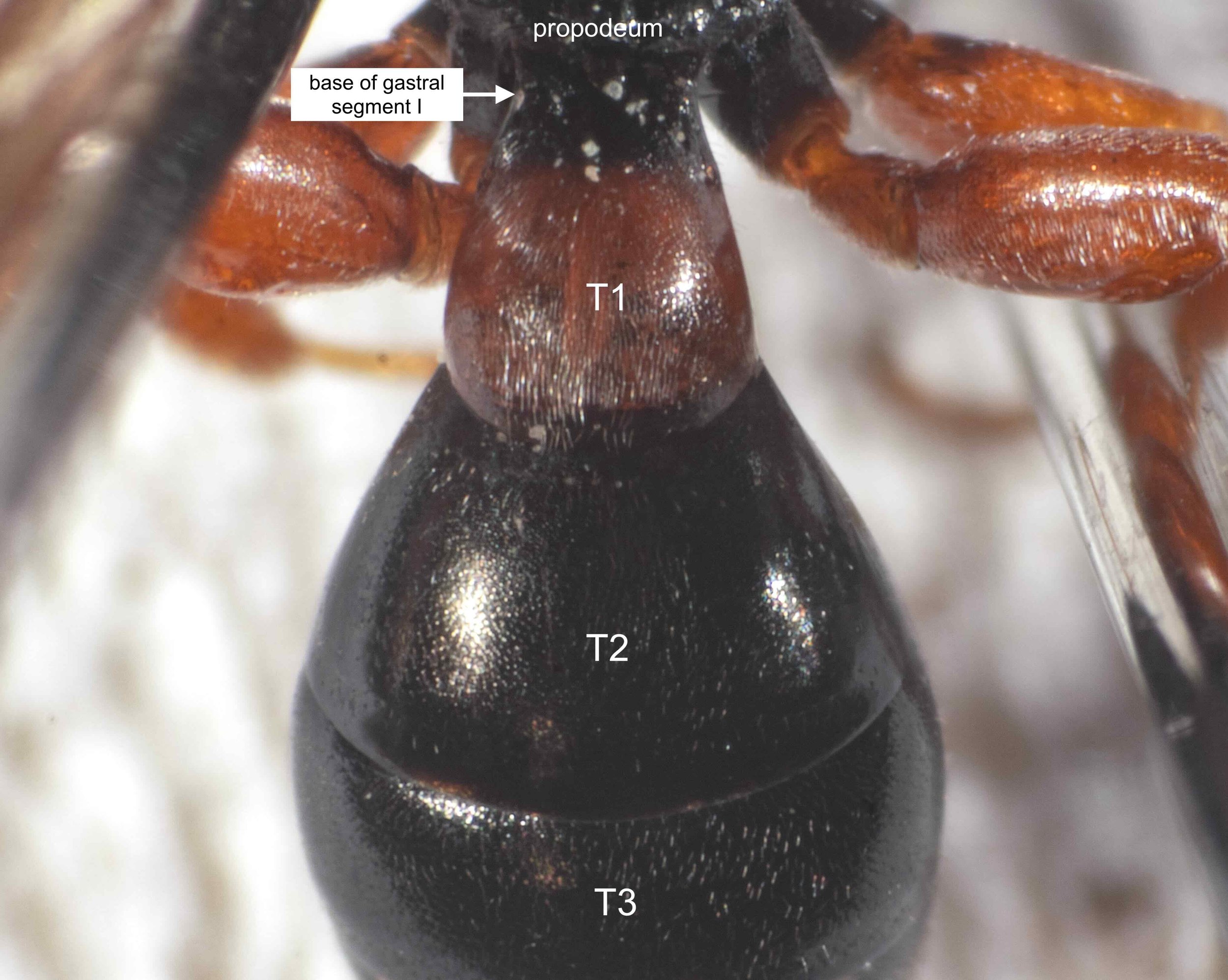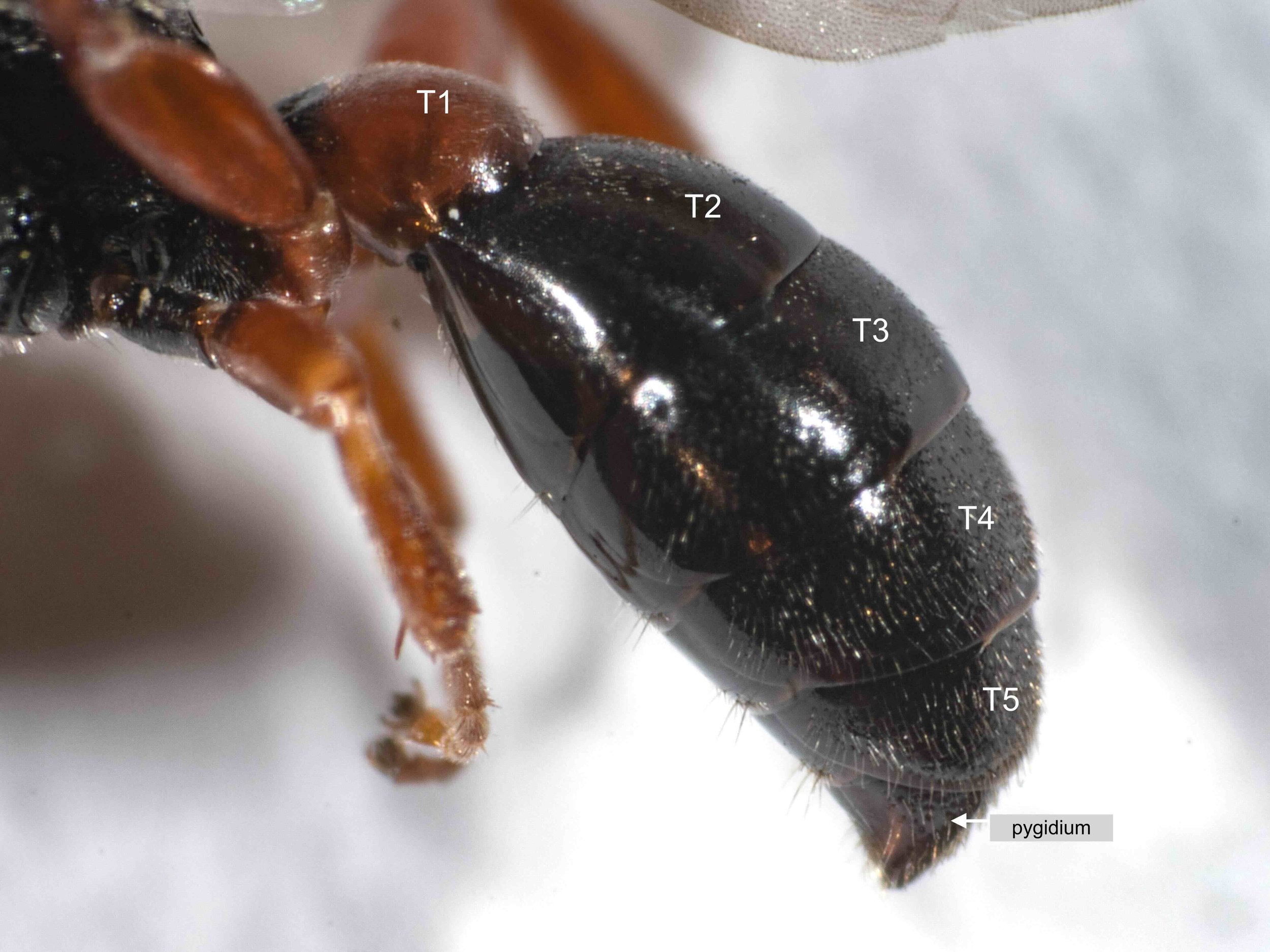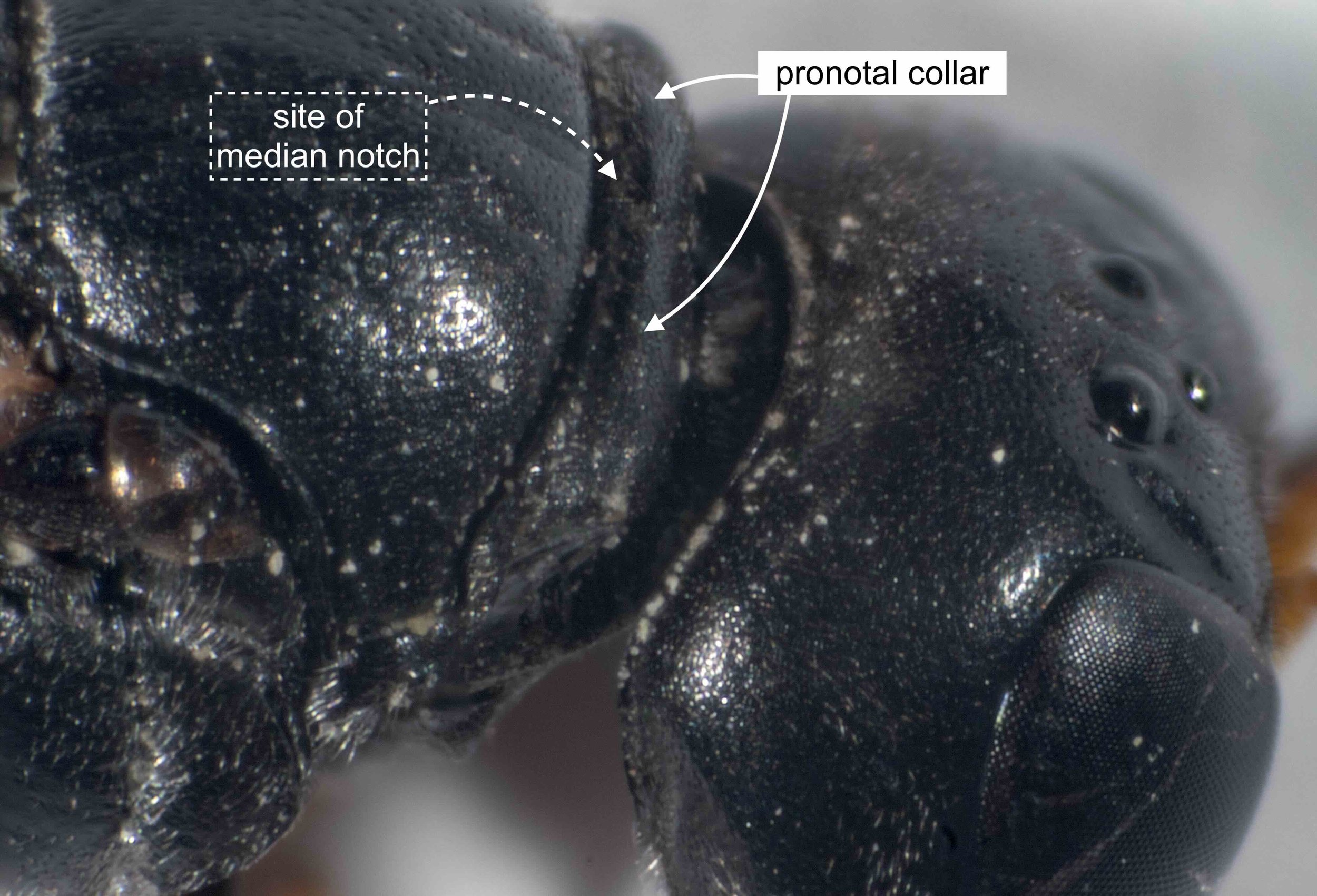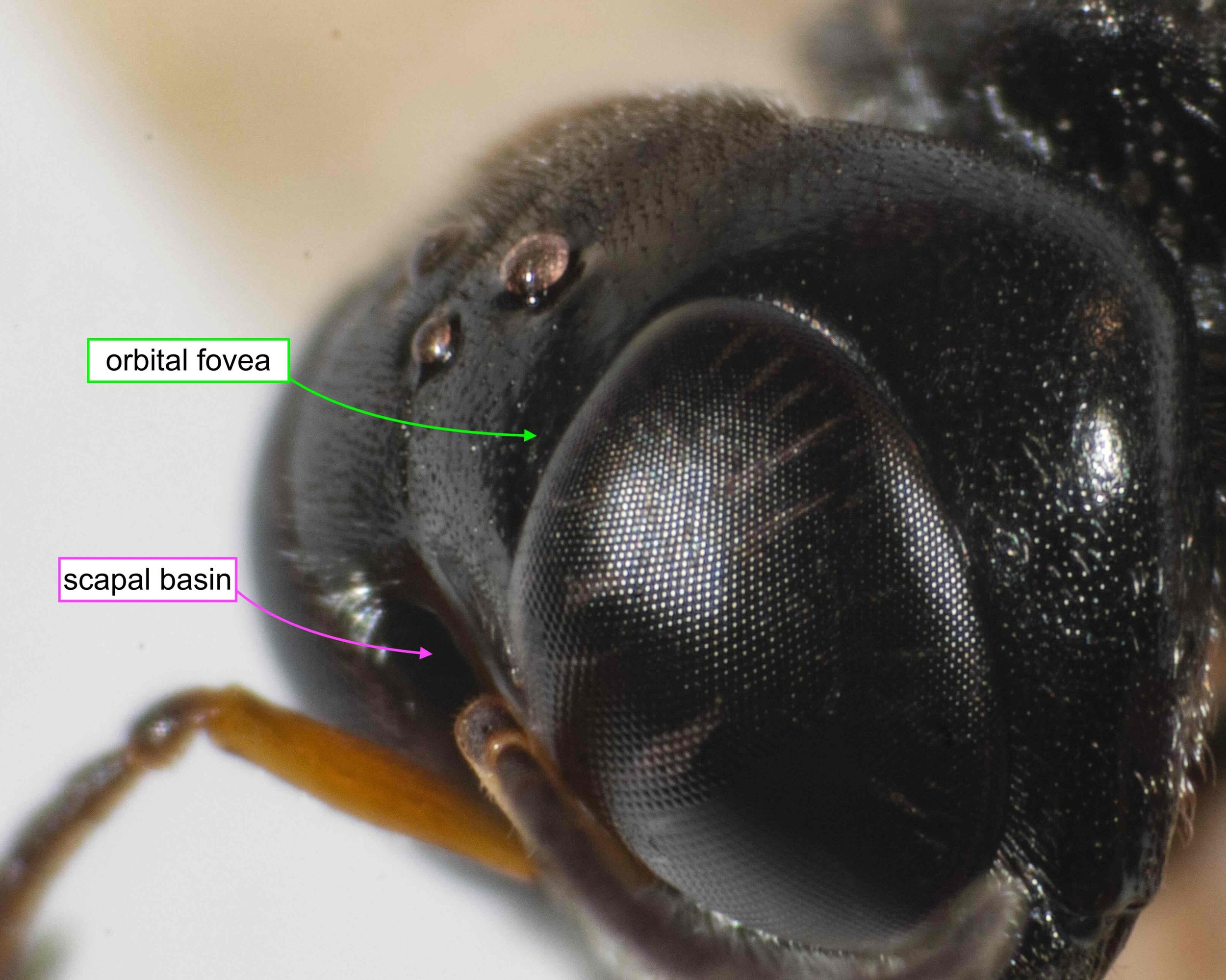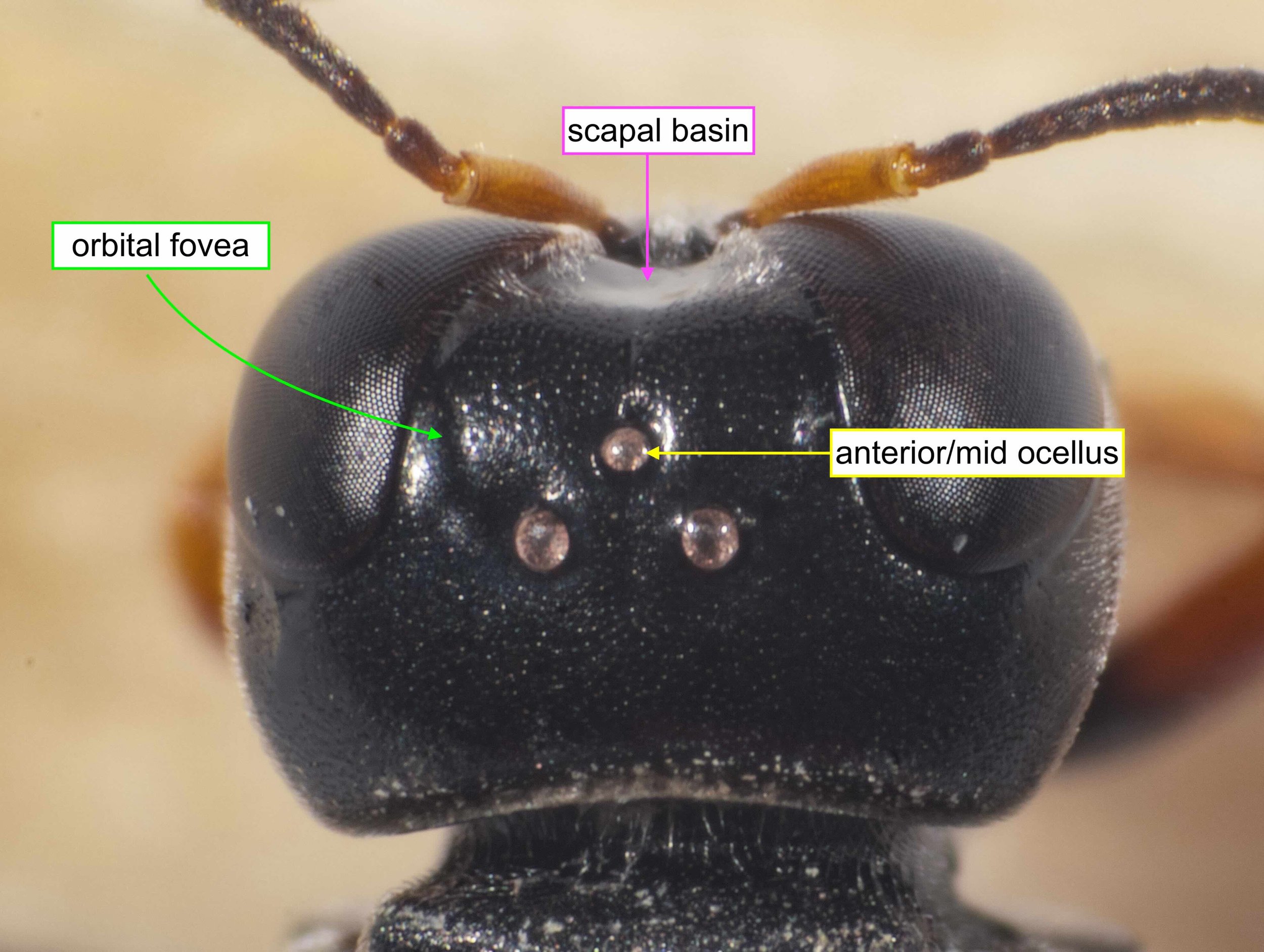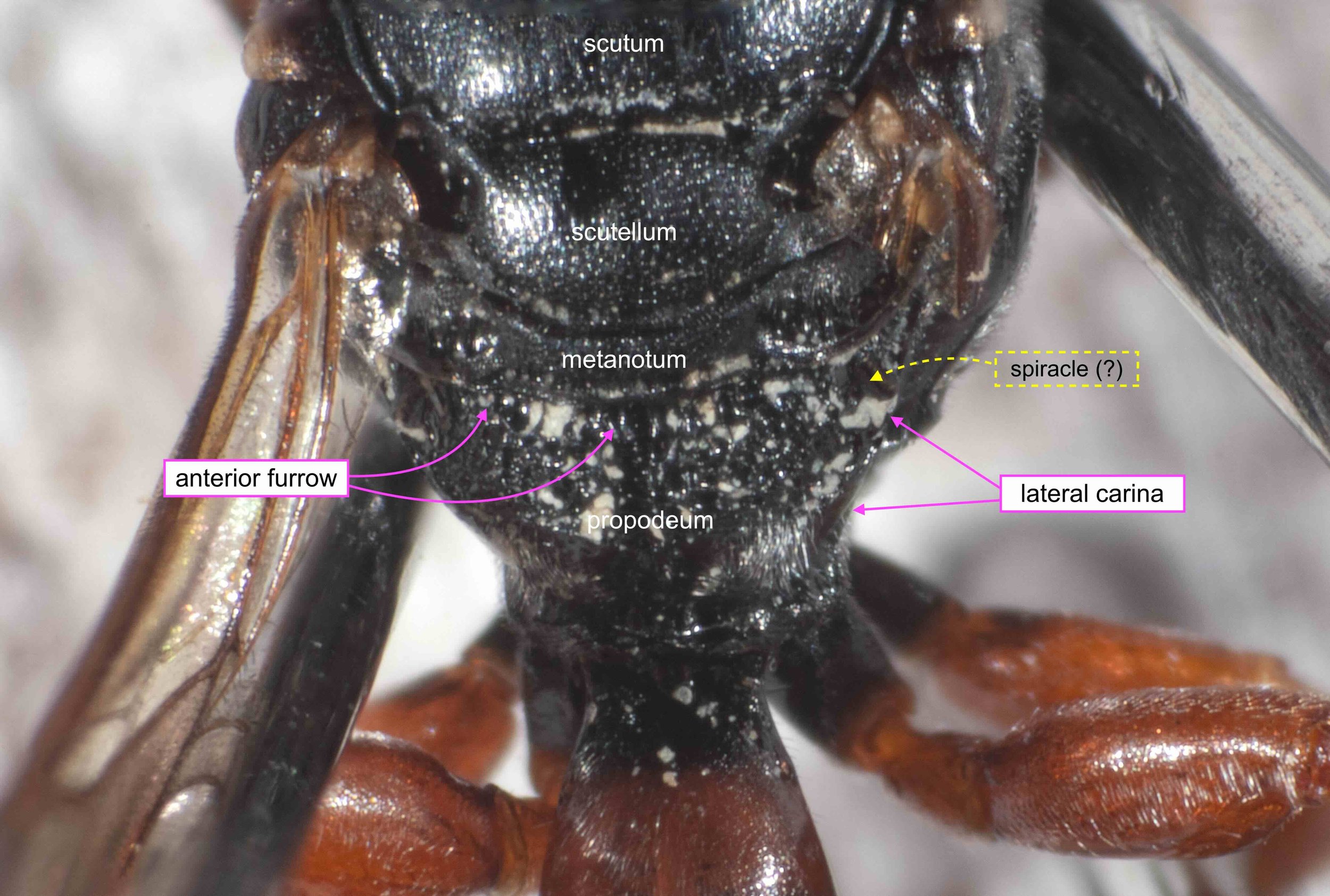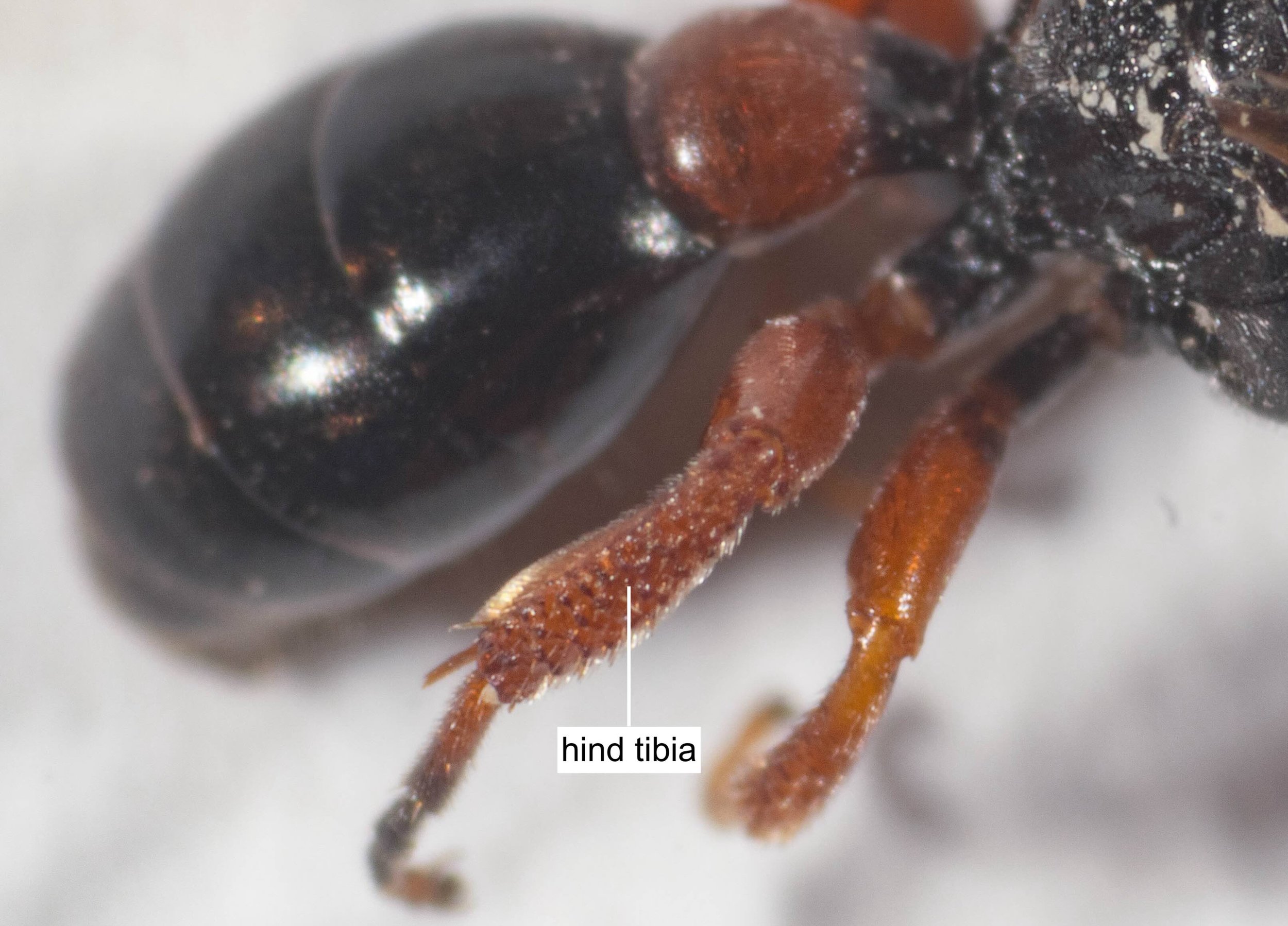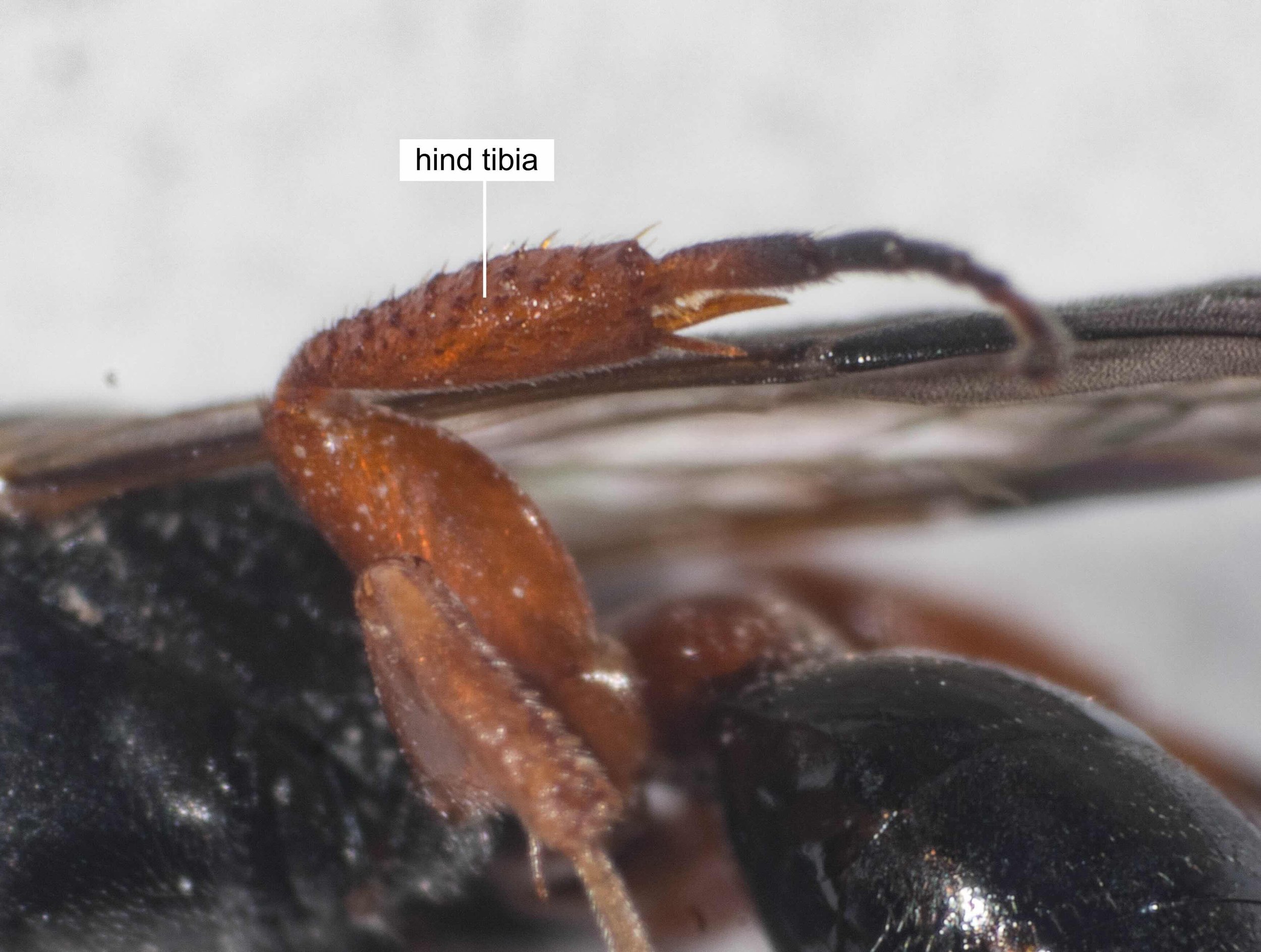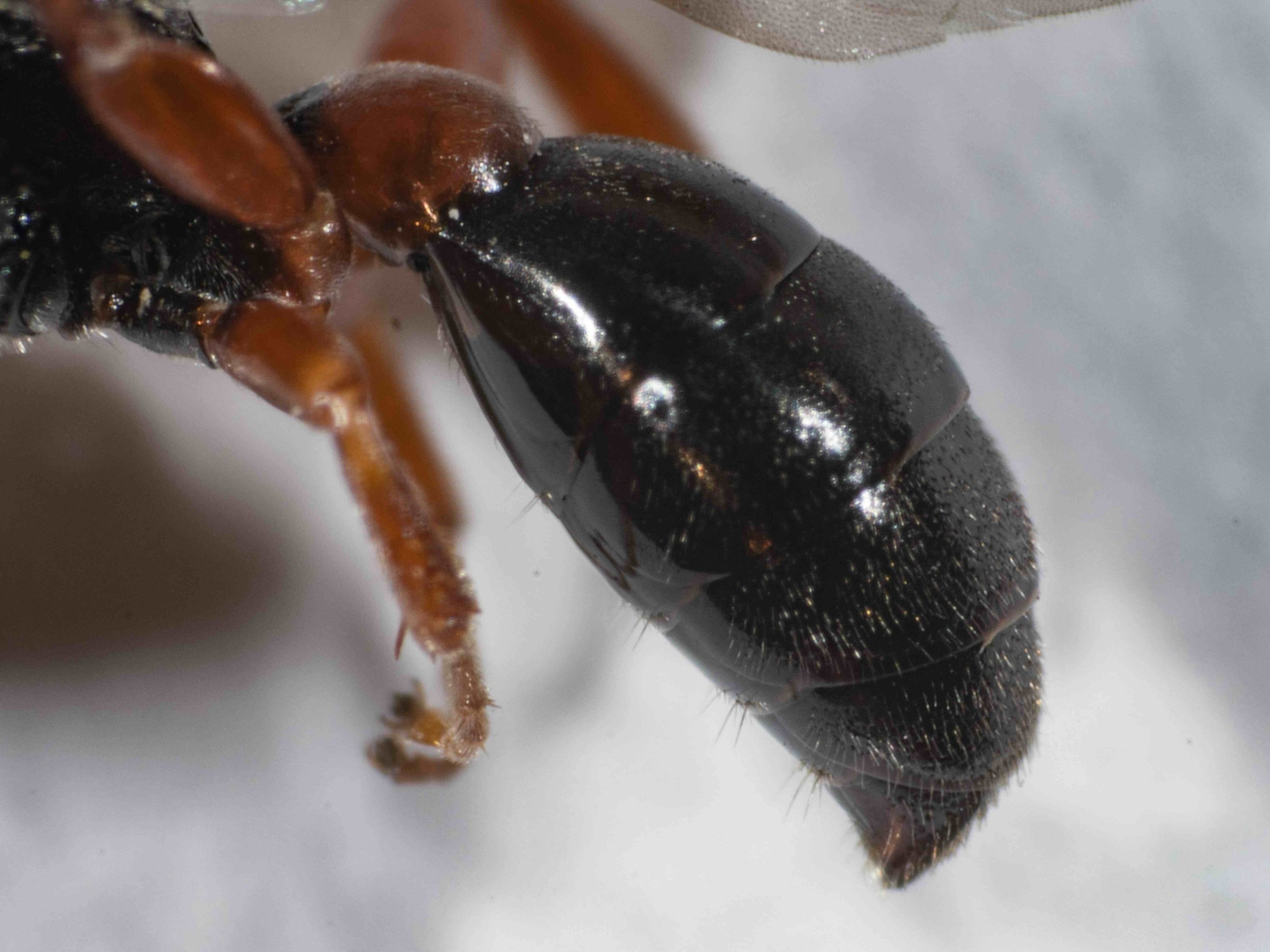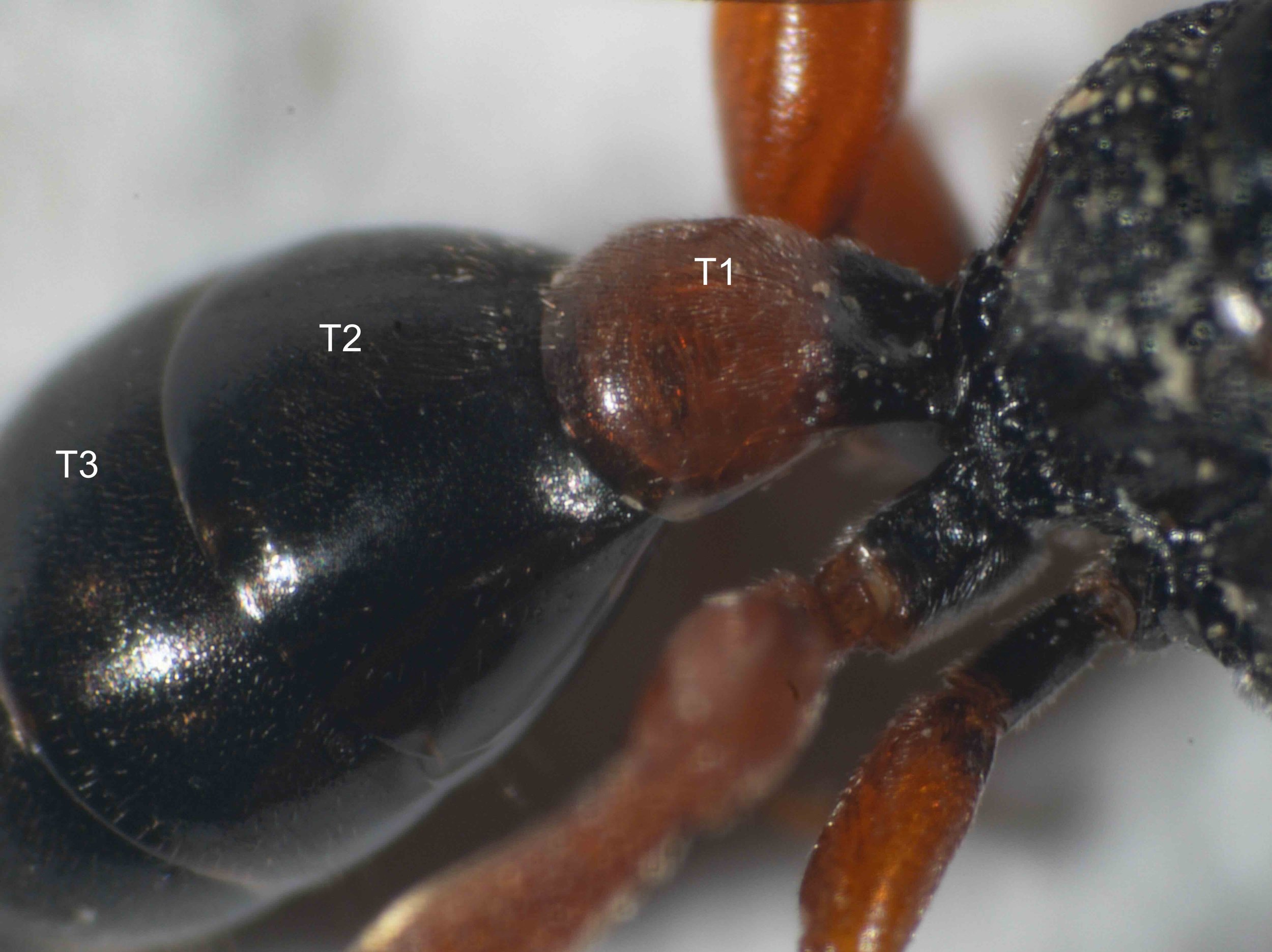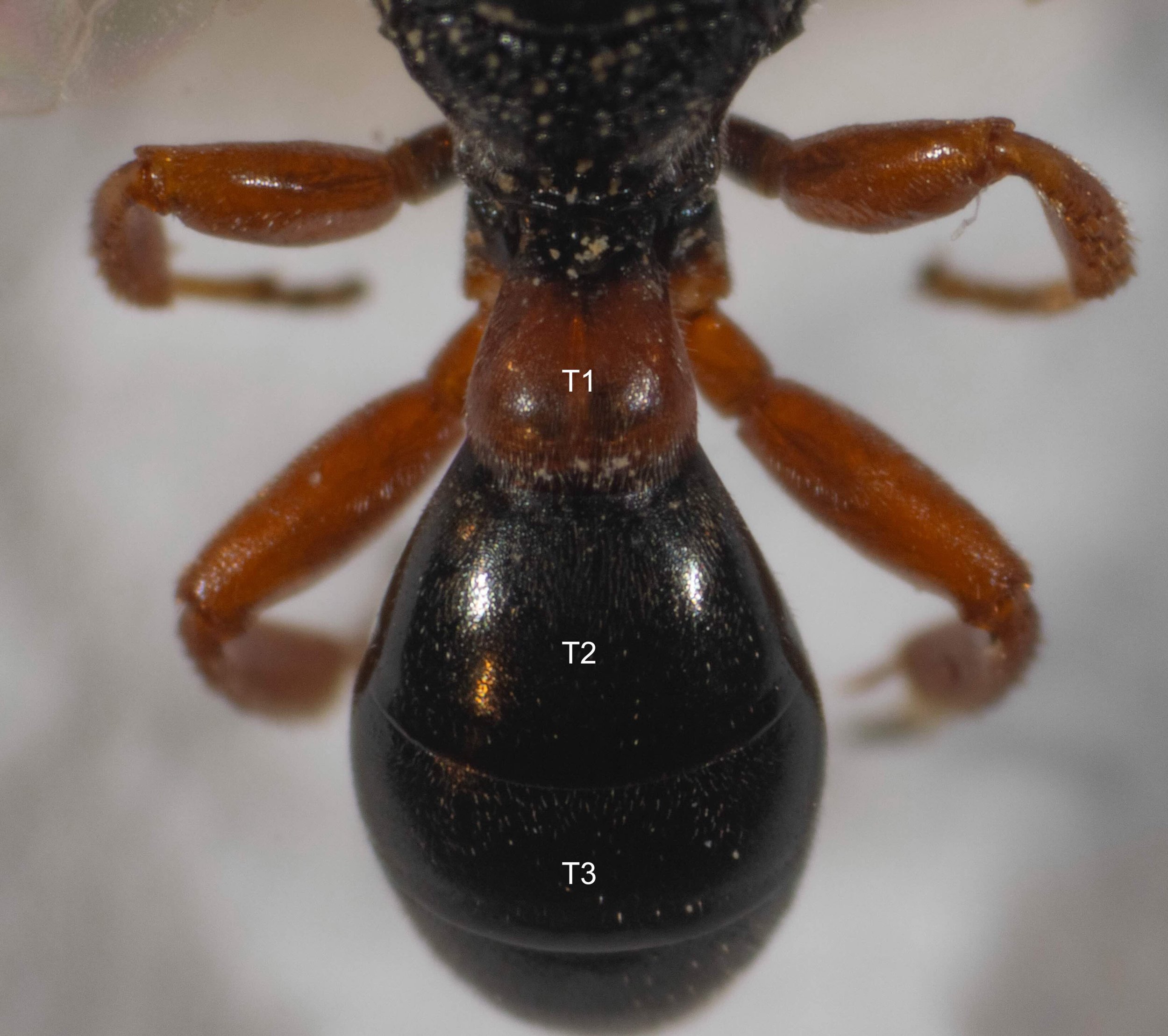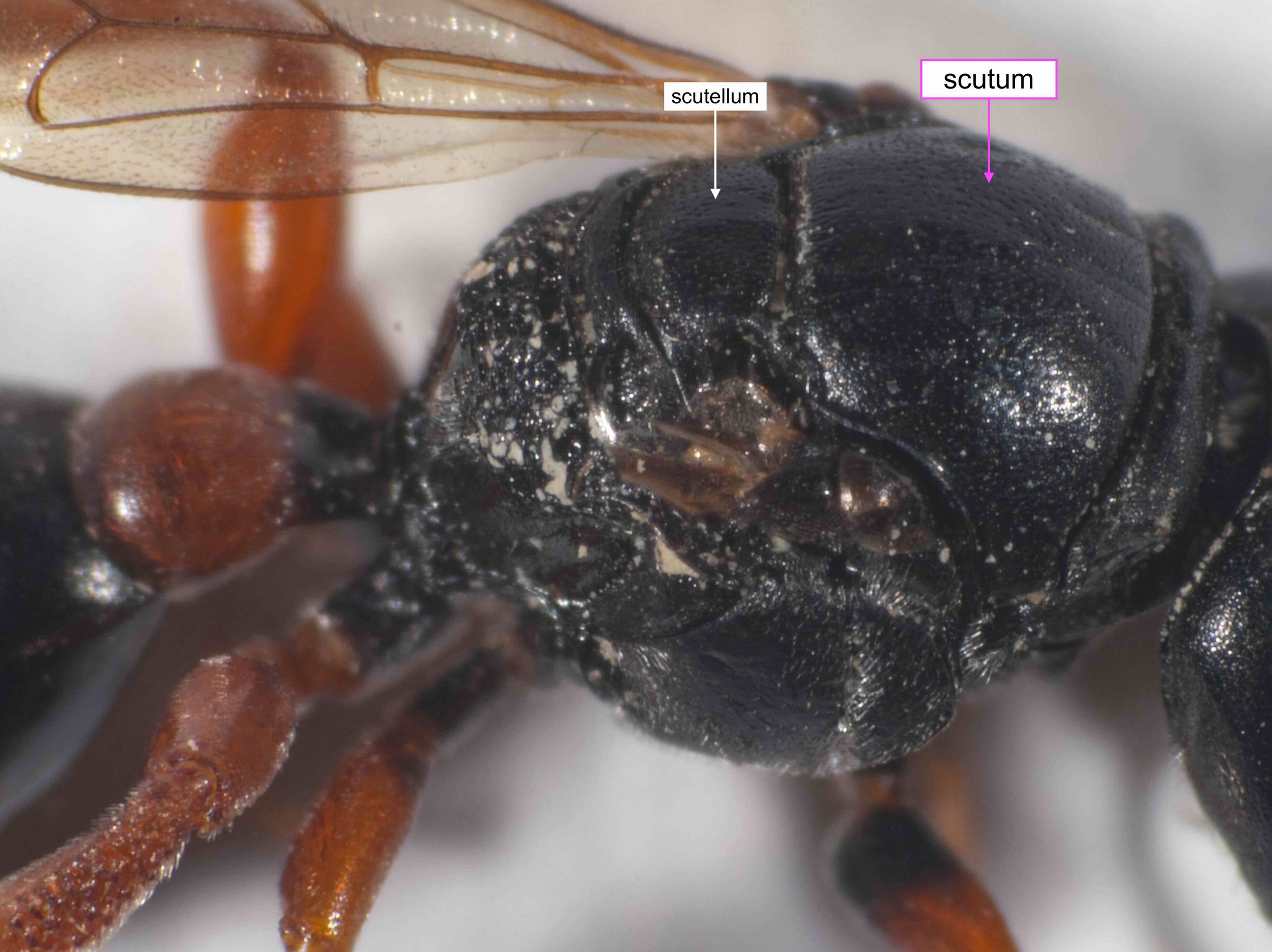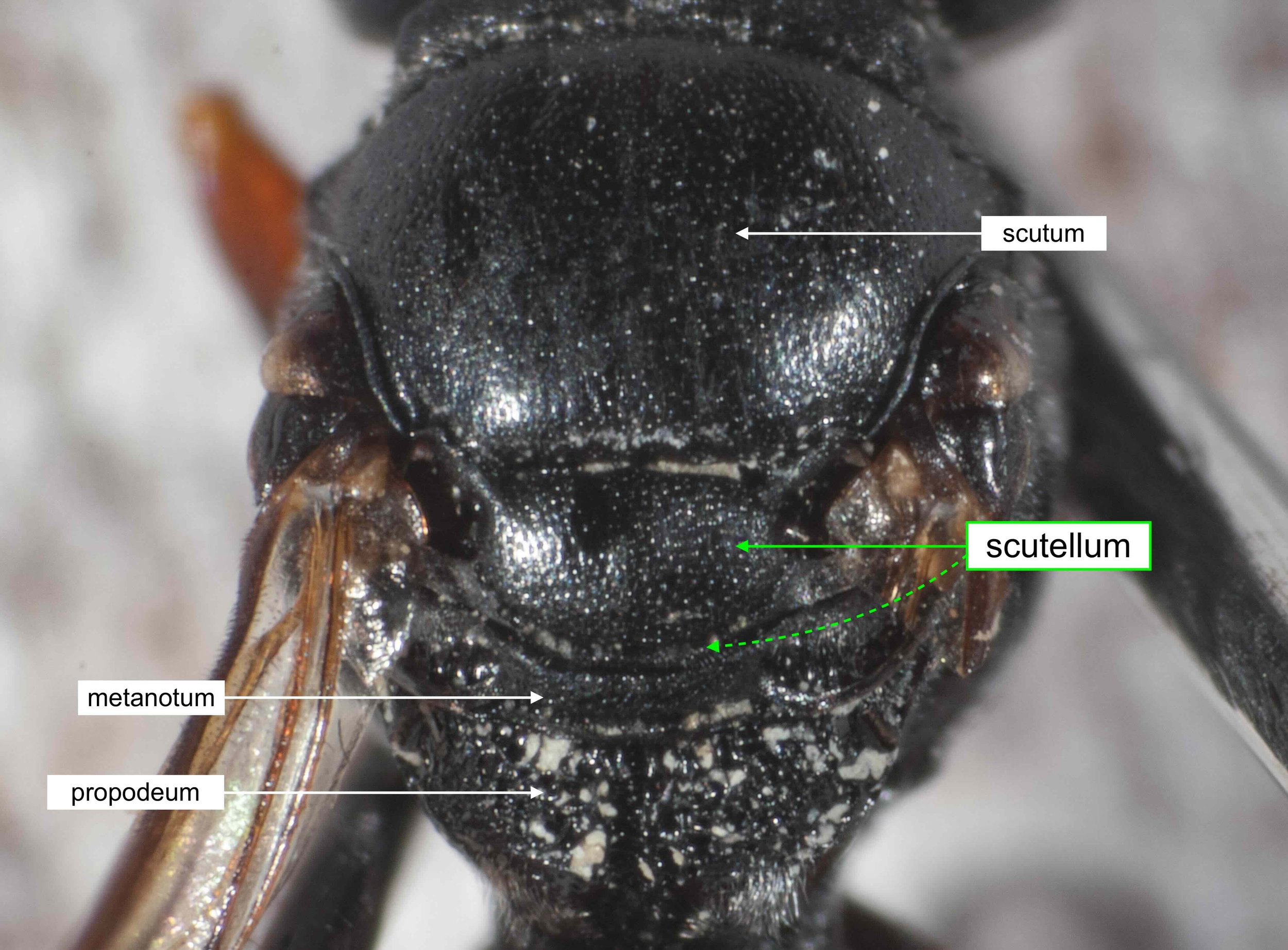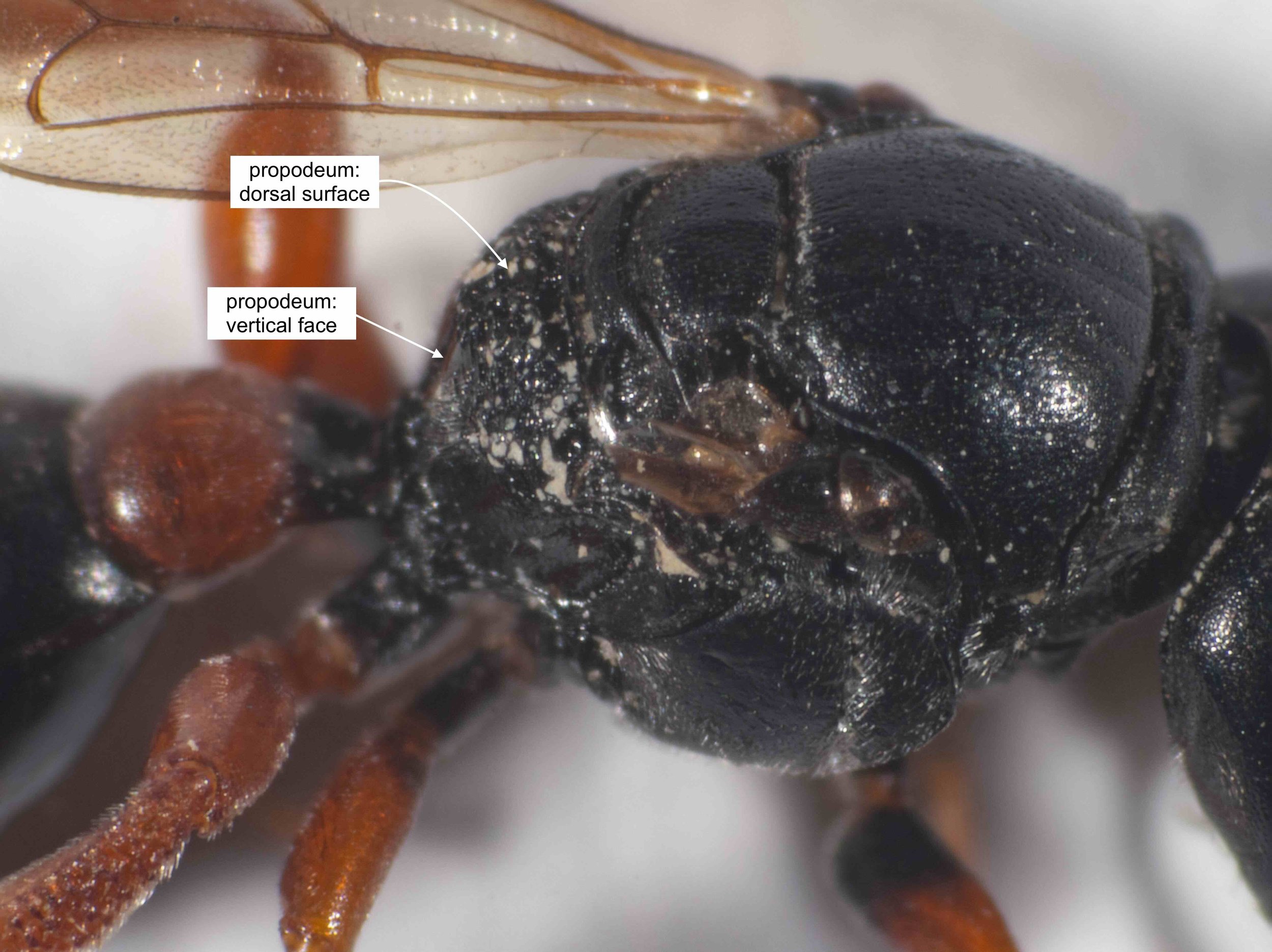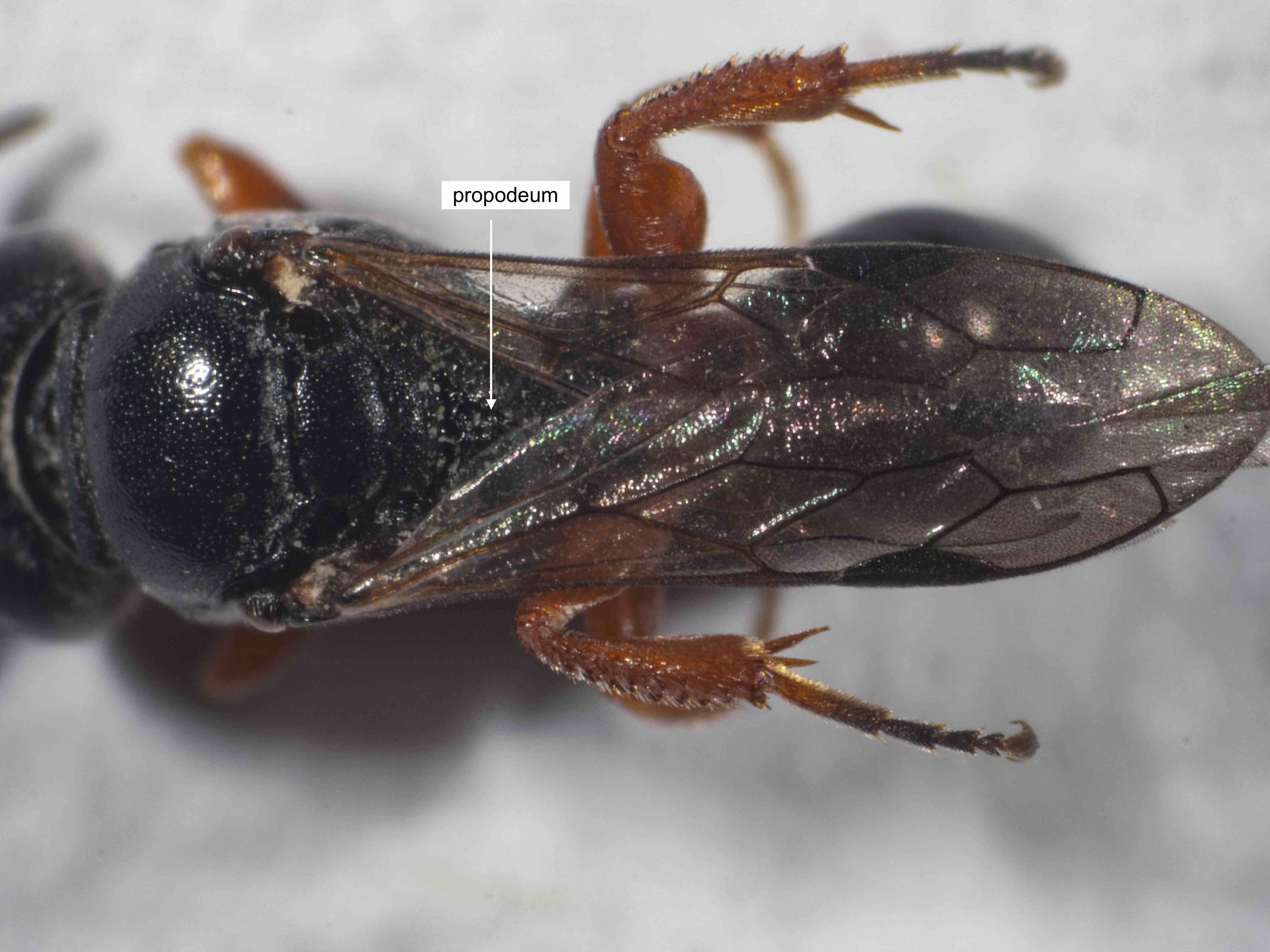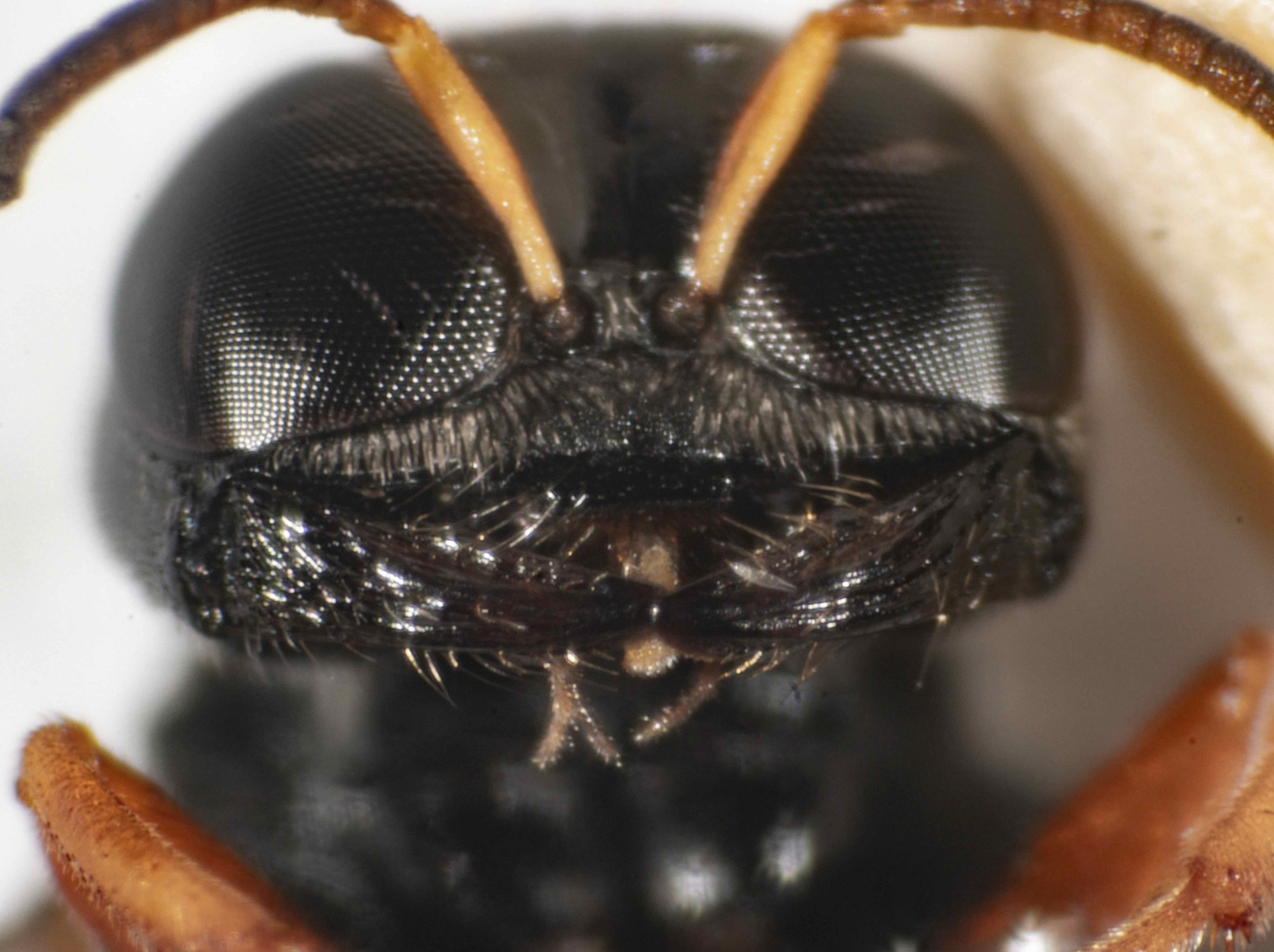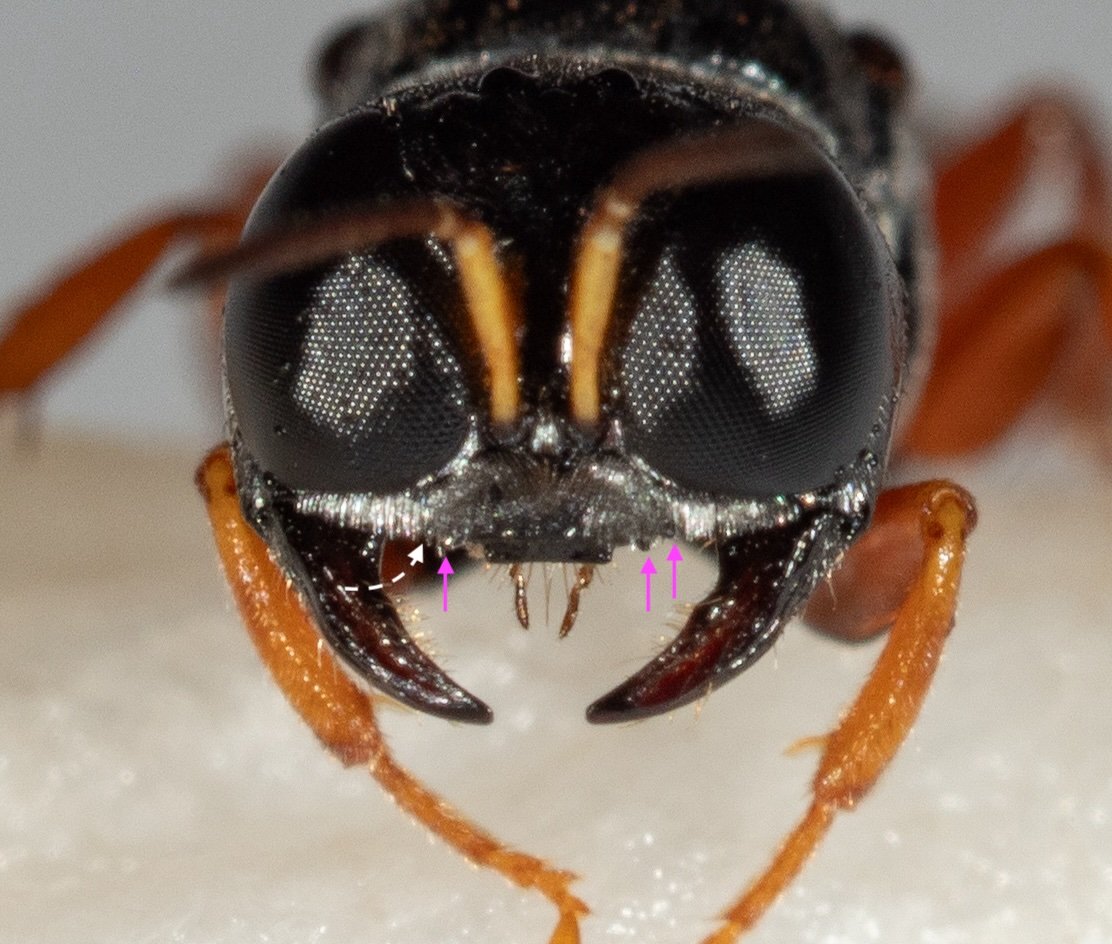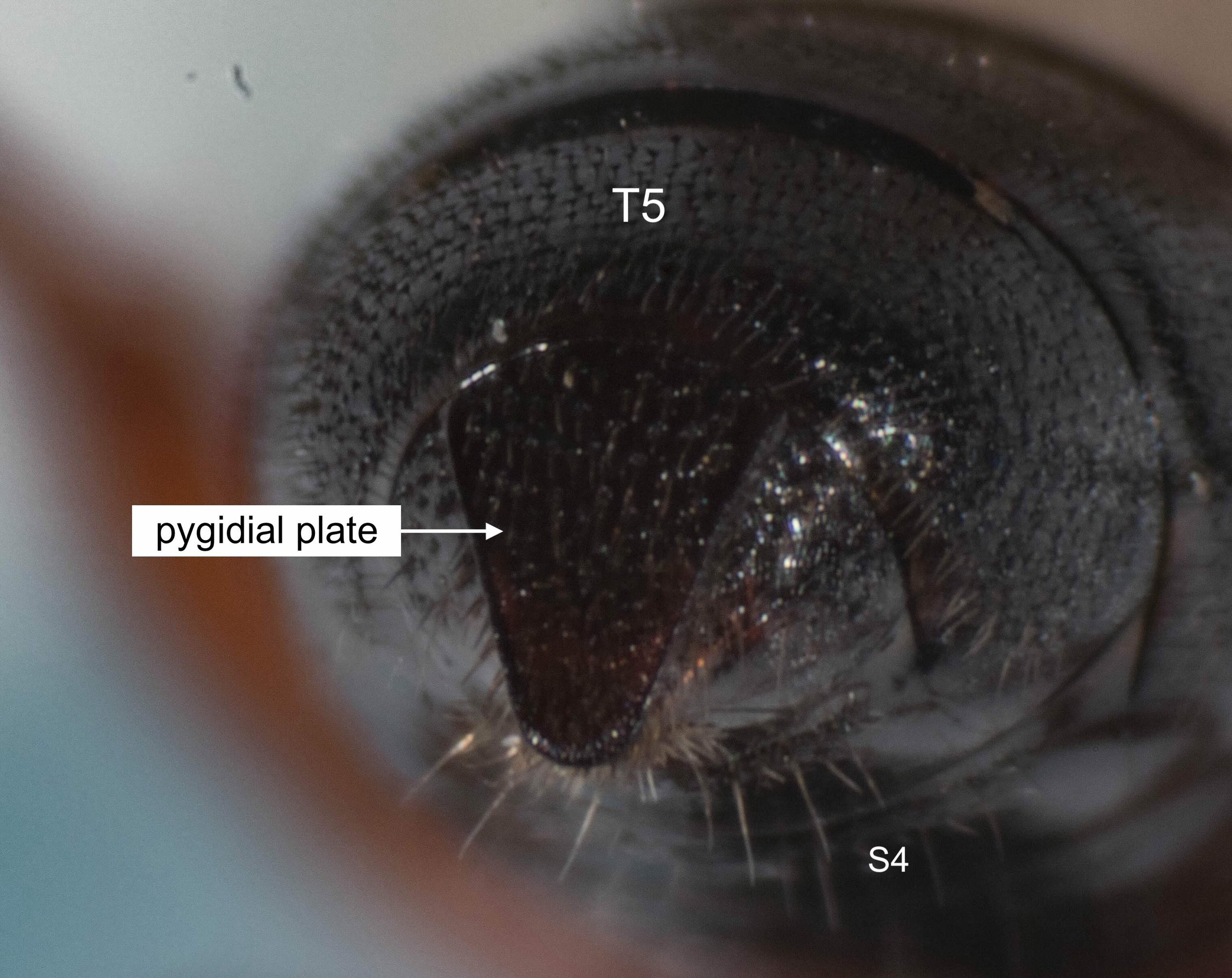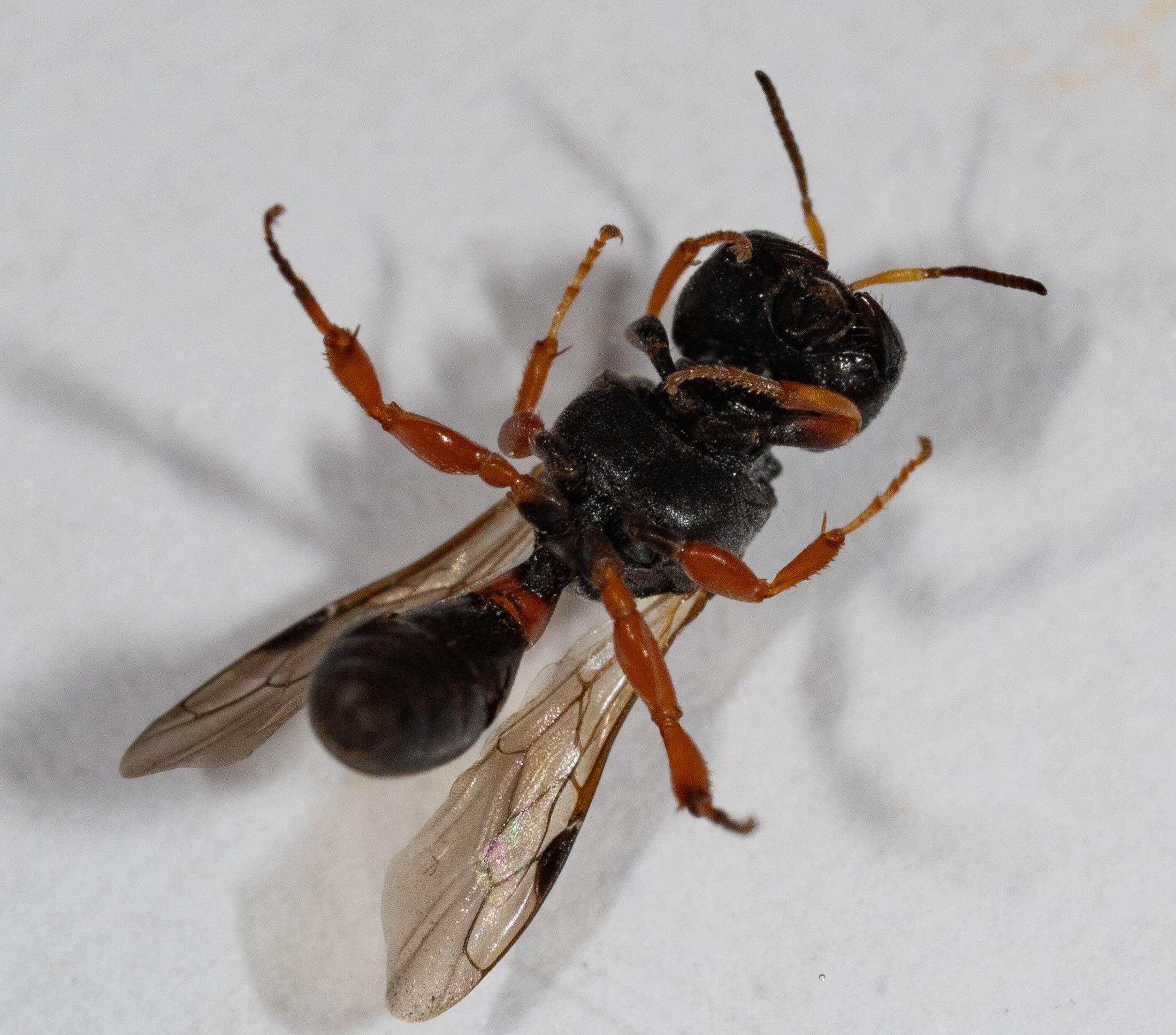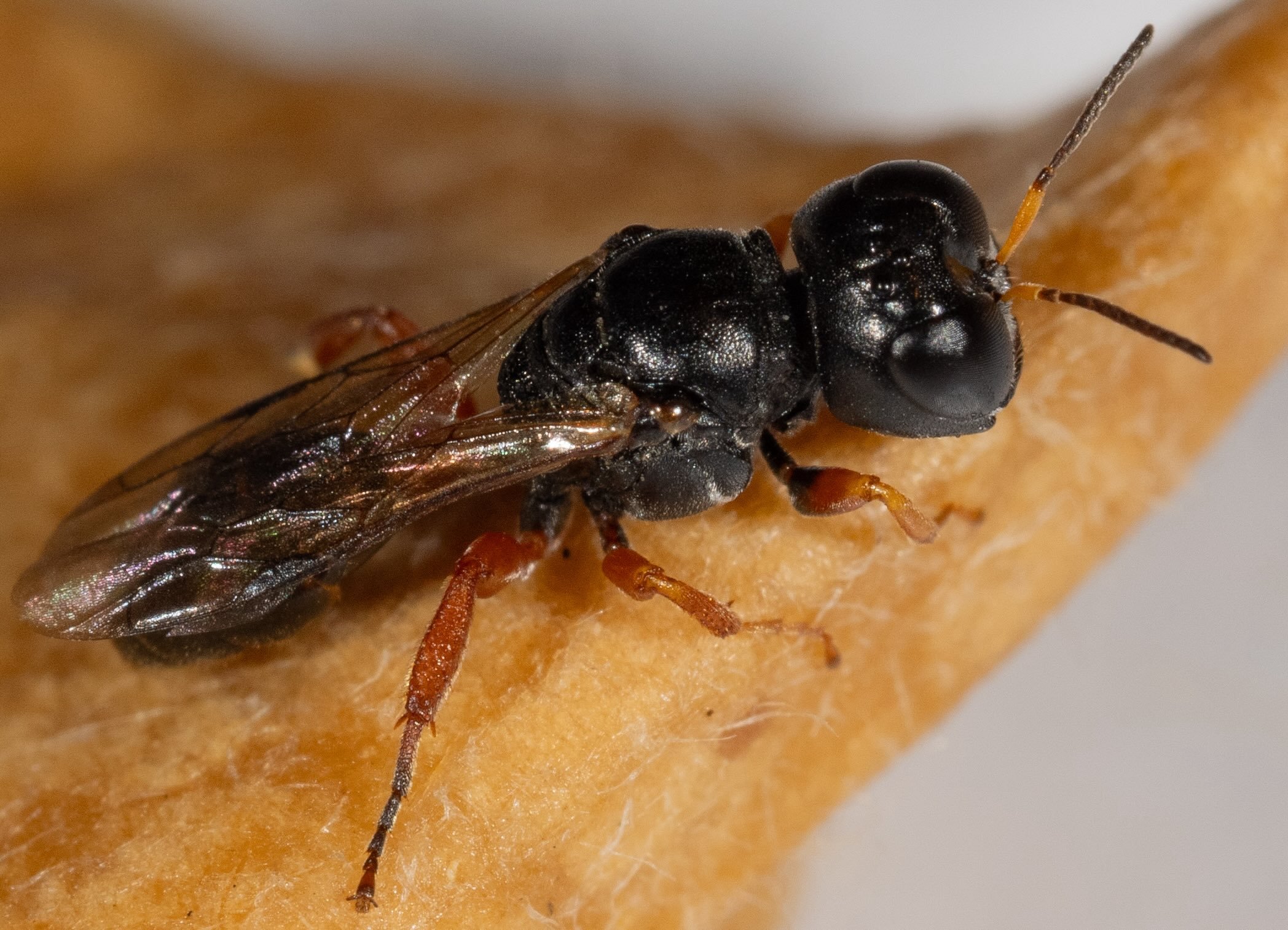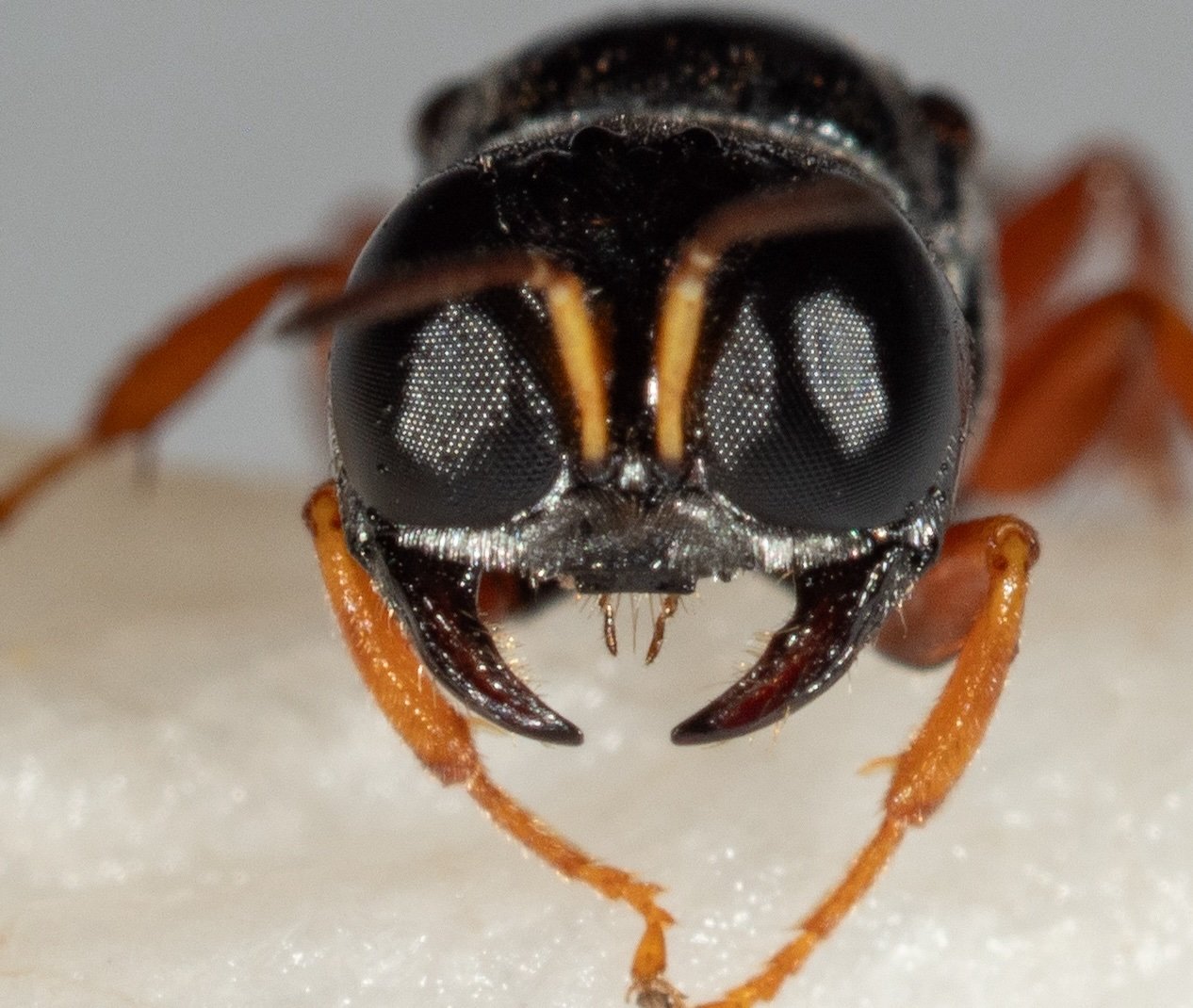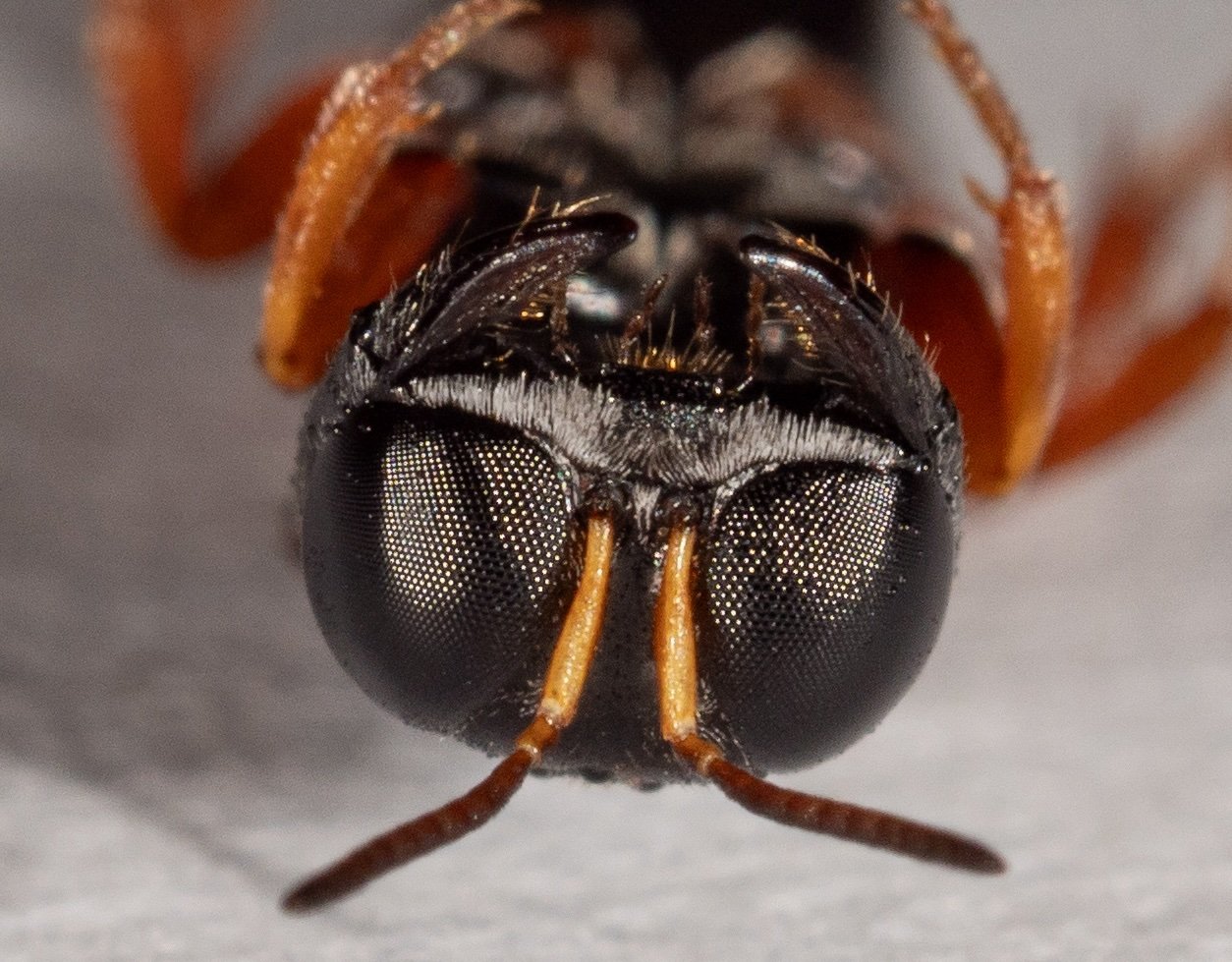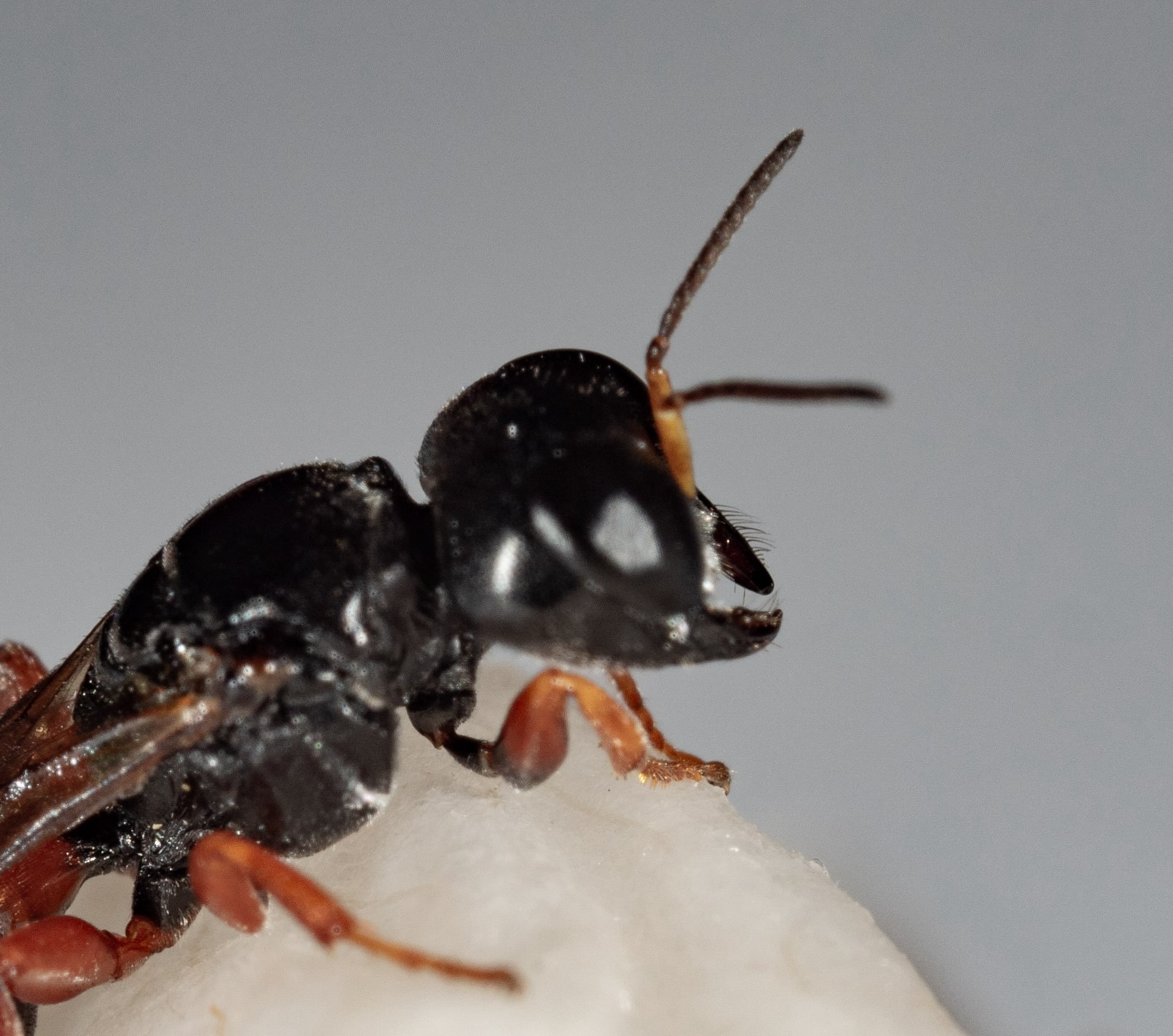Pseudoturneria (CRABRONINAE: Crabronini)
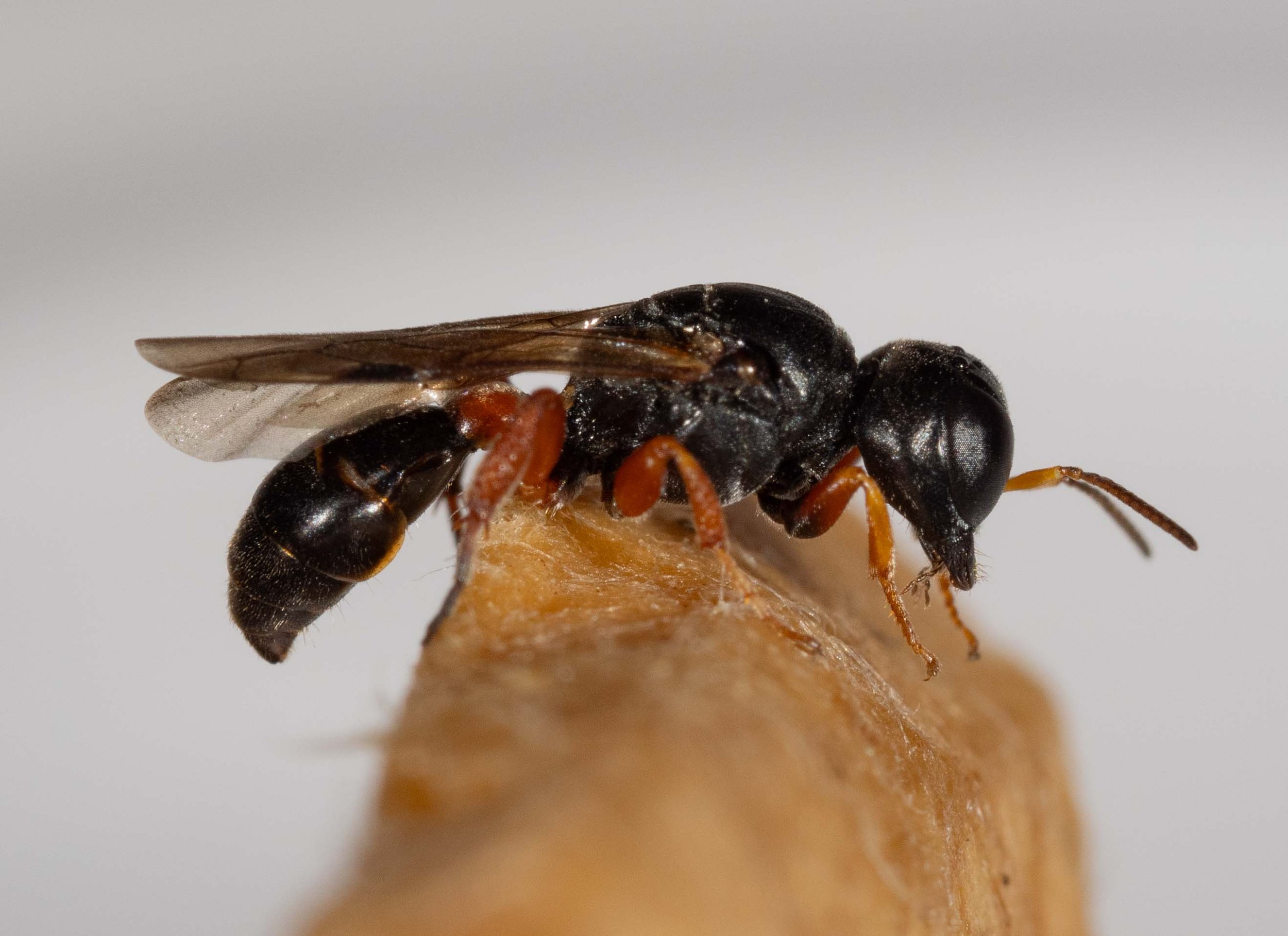
Workbook
These wasps have been attracting my attention for several months. Their bobbing flight with legs dangling is reminiscent of Rhopalum, and indeed that is what I initially assumed them to be. But when I finally collected a few for a closer look I got a real surprise!
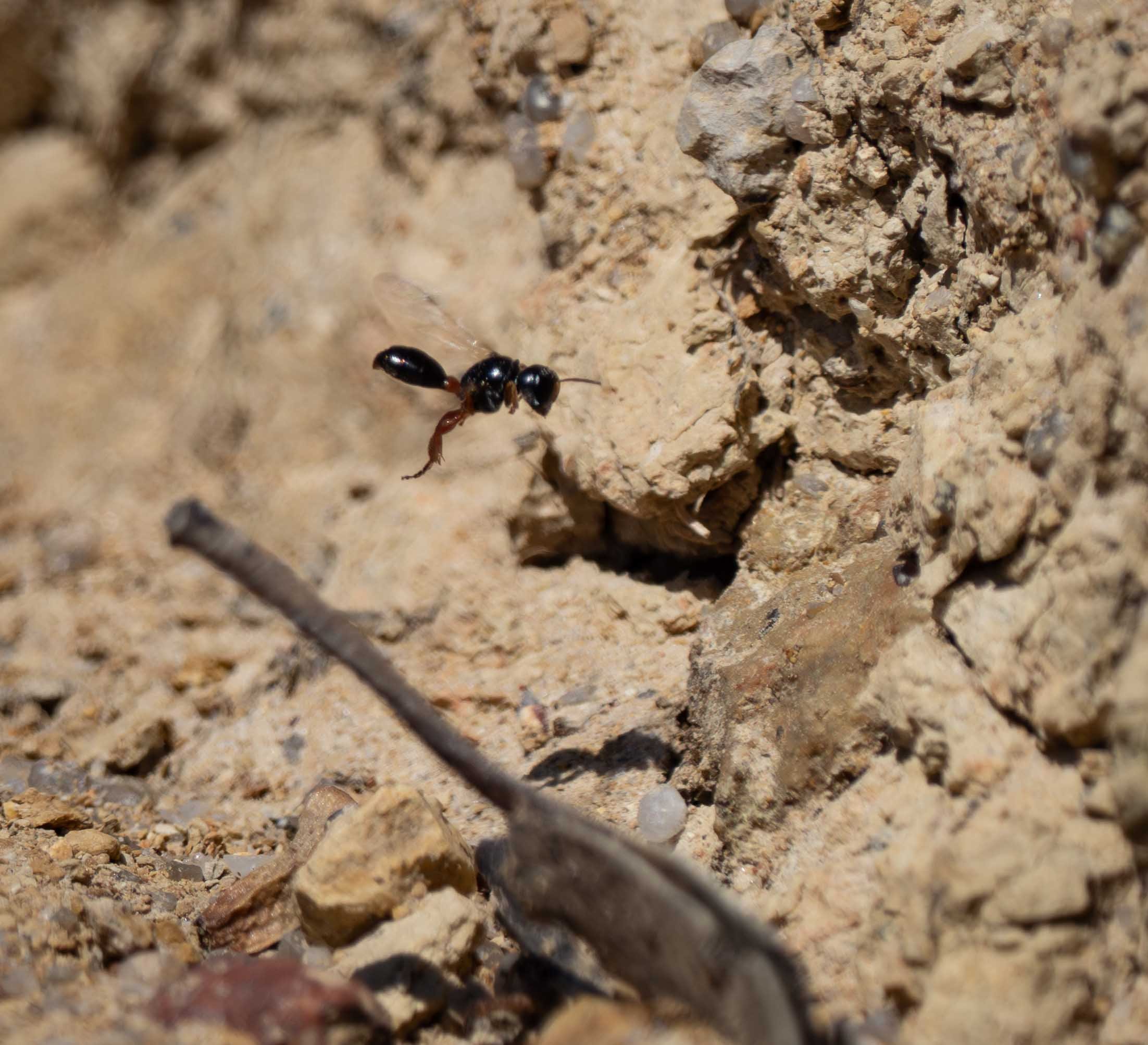
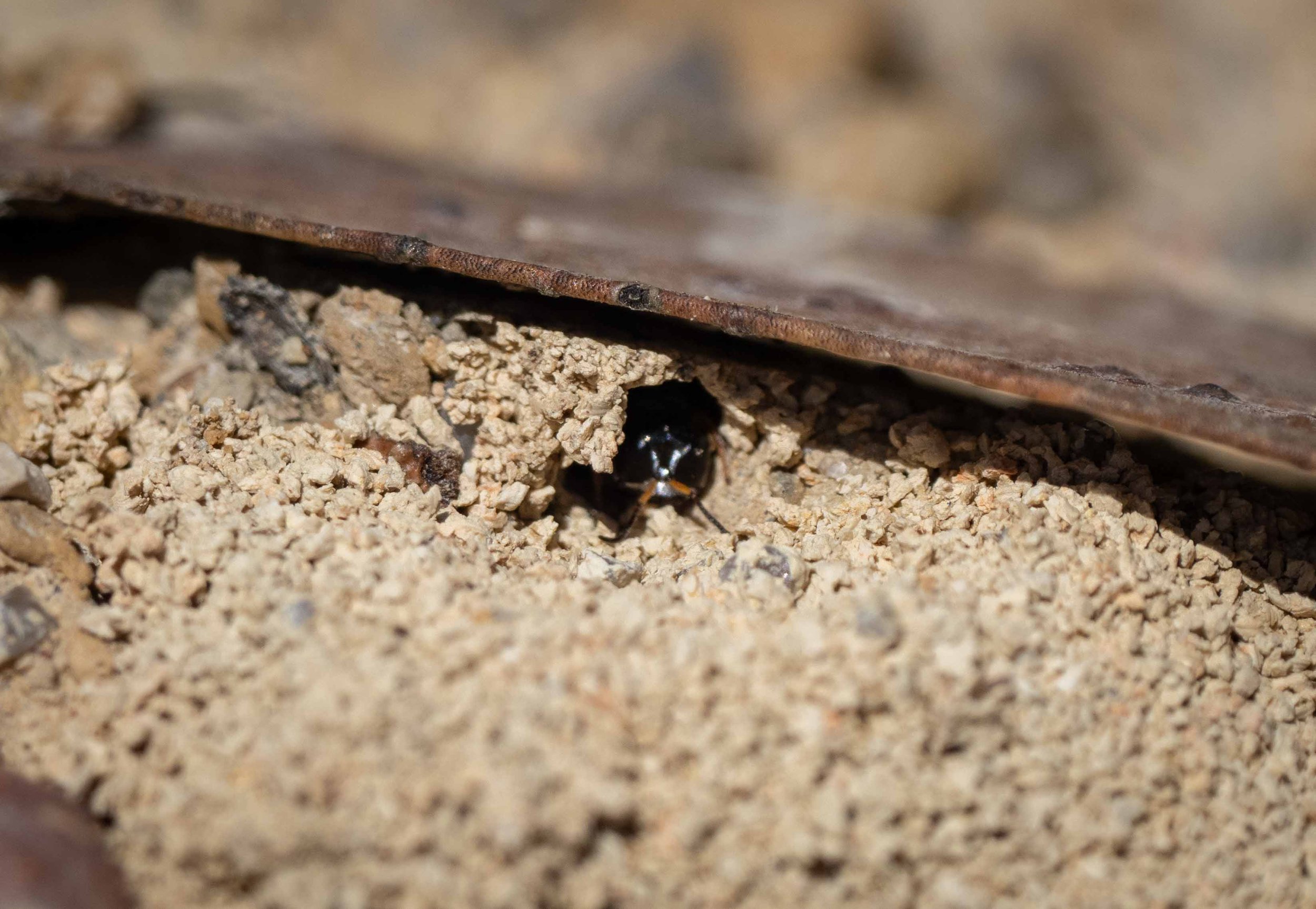
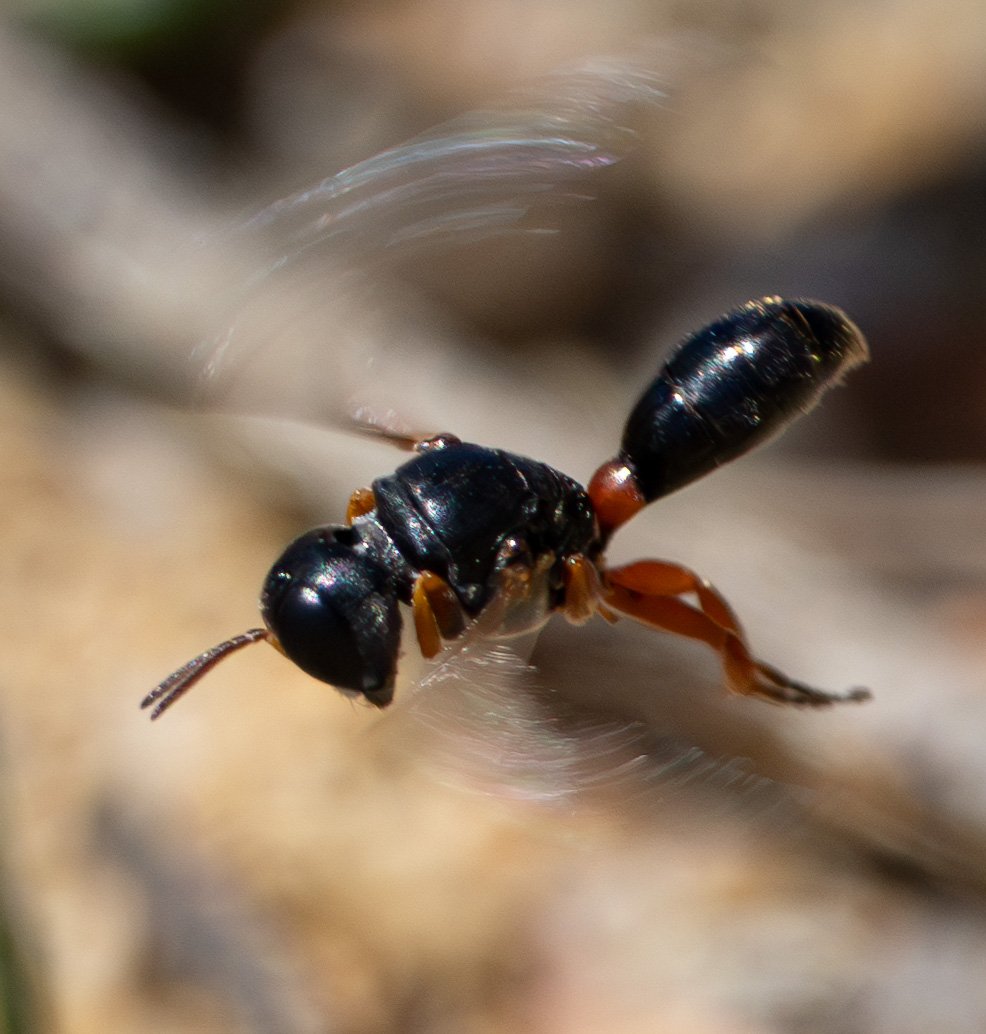
Pseudoturneria is a little known genus of crabronid … so rarely seen that until 1974 the genus was known from a single species (Pseudoturneria perlucida), the description based upon just three specimens from Mackay, QLD.
Leclercq (1974, 1998) went on to describe another four species from various states including NSW, Vic, SA and WA. But evidence of them in Australian collections remains scant, and I’ve been unable to locate any images online.
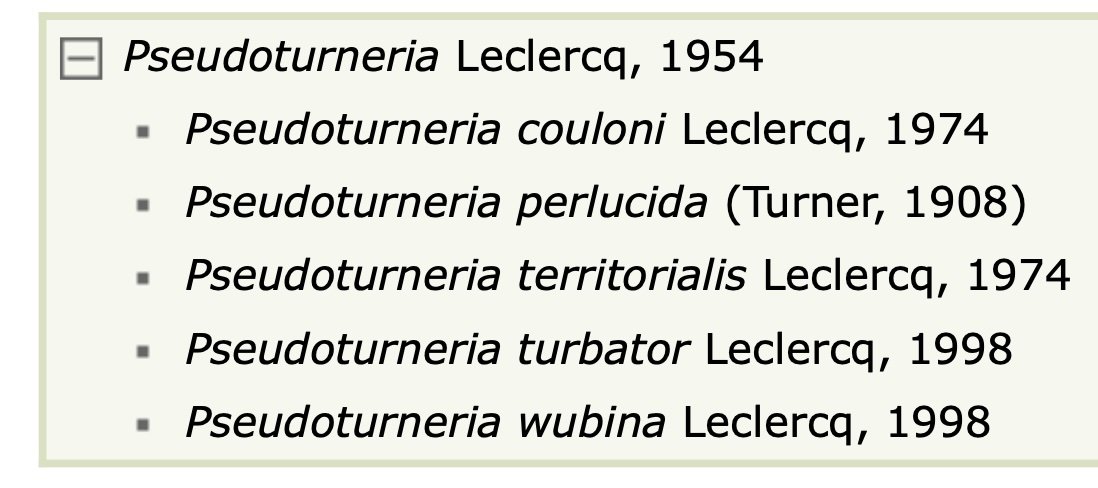
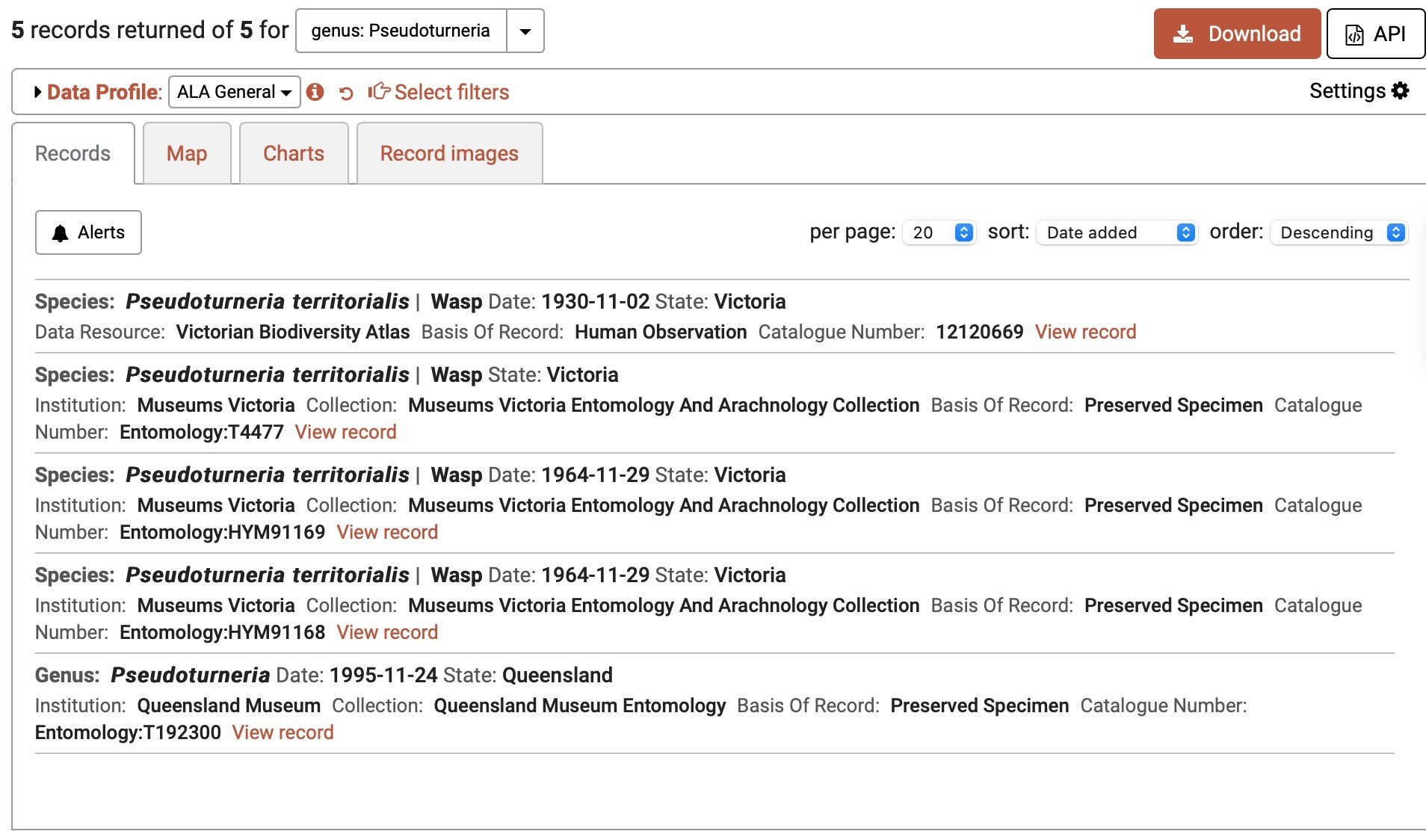
Hence my excitement to find an active nesting aggregation nearby – just 1km from home, in a ditch alongside a gravel road.
I’m now confident these are Pseudoturneria territorialis.
OK, it turns out that this is perhaps the most common species. By 1998, Leclercq had 45 specimens of P. territorialis available for study. And twenty of them were collected in the southeast corner of NSW (1998) not so very far from here (!) – a single male from Brown Mountain (1961) was among the paratypes, and 19 females were later collected on or near Clyde Mountain (1981).
As the latter were collected by Ian D. Naumann, most are probably lodged with CSIRO/ANIC, and so not currently listed on ALA. Hopefully that will change in the future, as ANIC records are digitised and made publicly available.
How my local collection can help
Although my local collection of six females is not entirely novel, I’d still argue that it makes a useful contribution to what is currently known and published on this species. In addition to insights into the species’ biology, the images will assist in identifying future observations on iNaturalist.
I’ve yet to find any sightings of Pseudoturneria on iNaturalist. Indeed, the genus has yet to be added to the taxonomy (but we’ll fix that soon!). Of course, it’s possible that there are observations of this genus lurking in the dataset somewhere, unidentified or misidentified. Pseudoturneria can easily be mistaken for several other Crabronini, particularly Rhopalum, Podagritus, or Notocrabro (Leclercq 1998), and the diagnostic features will be difficult to discern in field photos.
So, my aim with this page is to provide detailed, annotated images as an example, and to develop a summary of diagnostics for each of the five known species. This should help us uncover any existing sightings on iNaturalist and facillitate recognition in the future.
Specimen numbers in my collection are: 2411F, G, H, I (all collected 24th Nov. 2024) & 2412B, C (both collected 19th Dec. 2024). I plan to lodge most of them with museums, for the reference of future researchers. All six are females. I suspect that males were active during spring. Next year I will be on the lookout for them.
Step 1: tribe Crabronini
The wasps are quite obviously Crabronini … the characteristic ‘silver-moustache’, eye shape and forewing venation are the most obvious clues.
The full set of features that distinguish the tribe Crabronini from all other Crabronidae genera is summarised on the crabronid hub page, and in the matrix in particular.
The wasps I collected display each of these features:
CRABRONINI have:
- a single submarginal cell
- media diverging beyond cu-a
- stigma tapering to a point well beyond base of marginal cell
- marginal cell apex truncate or rounded (not pointed)
- single discoidal cell (usually)
CRABRONINI have:
- antennae inserted low on face, sockets close to frontoclypeal suture
- eyes nearly always converging below, often strongly
- eye facets usually enlarged ventrad, crowding the antennal sockets
- face often with silvery transverse clypeus & vertical pale scapes forming a distinctive U shape
CRABRONINI have:
- normal ocelli
- large cuboidal head
- eye entire, not notched or strongly emarginate
- eyes nearly always converging below, often strongly
- frons often with scapal basal
CRABRONINI have:
- episternal sulcus present
- scrobal sulcus usually absent
CRABRONINI have:
- pronotal collar short
- pronotal lobe & tegula separated
Step 2: genus Pseudoturneria
There are 13 genera among Australian Crabronini, and distinguishing between them can be a challenge. In some cases, the combination of gaster shape and forewing venation suffices … but usually more information is needed. Of particular importance is the structure of the thorax, laterally.
Refer to Crabronidae Hub for generalised diagram of mesopleural architecture & terminology.
The matrix and notes on the page for Crabronini summarise the differences between the genera in this tribe.
The wasps I collected match the most current description and diagnosis for the genus Pseudoturneria (Leclercq 1998):
Pseudoturneria have:
- wide, flat perpectus forming a perpendicular plane to flat omaulal area
- omaulus strong
These features distinguish Pseudoturneria from those Rhopalum species that have a much reduced peduncle.
Pseudoturneria have:
- omaulus strong, continuous with postspiracular carina dorsally & reaching episternal sulcus ventrally
- episternal sulcus wide, crenulate
- scrobe small
- verticaulus absent
Pseudoturneria have:
- wide, flat perpectus forming a perpendicular plane to flat preomaulal area
- omaulus strong, continuous with postspiracular carina dorsally (collectively called the epicnemial carina by Leclercq … carène épicnémiale)
Pseudoturneria have:
- junction of recurrent vein & submarginal cell (SCI) slightly beyond middle; ratio of basal segments of SCI close to 5:4 (in contrast to Podagritus which are always about 5:2 in Australian species)
Pseudoturneria:
- are small in size, ranging from 4-6.5mm head-body length
- have a stocky appearance with a subsessile gaster (in contrast to all Australian Podagritus, which have an elongate form and pedunculate gaster)
Pseudoturneria have:
- segment I much narrower that segment II
- segment I short, only slightly longer than wide
- gaster widest at segment II or III
Pseudoturneria have:
- gaster subsessile due to a very clear constriction between segments I & II
- segment I thick & relatively short
- segment I without dorsoposterior spine (in contrast to this diagnostic feature of Notocrabro)
- segments II-V regular, ovoid
- gaster widest at segment III
Pseudoturneria have:
- pronotal collar rounded, without a carina
- median notch of collar indistinct or minimal
Pseudoturneria have:
- indistinct orbital fovea
- scapal basin simple, without dorsal carina
Pseudoturneria have:
- indistinct orbital fovea
- scapal basin simple, without dorsal carina
- ocelli in a moderately high triangle, only slightly broader than long
- the anterior ocellus smaller than hind/lateral ocelli
Pseudoturneria have:
- anterior furrow wide, deep, & strongly crenulate
- dorsal surface coarsely sculpted (in contrast to Notocrabro which has fine sculpturing)
- dorsal surface separated from sides by lateral carina, extending from the spiracle
Pseudoturneria have:
- hind tibia of regular thickness, not clavate or otherwise strongly swollen (in contrast to Notocrabro, Podagritus and most Rhopalum)
- in females, the hind tibia is strongly spinose
Pseudoturneria have:
- hind tibia of regular thickness, not clavate or otherwise strongly swollen (in contrast to Notocrabro, Podagritus and most Rhopalum)
- in females, the hind tibia is strongly spinose
Step 3: Pseudoturneria territorialis
There is no doubt in my mind that my local wasps are Pseudoturneria territorialis. They match Leclercq’s descriptions perfectly (Leclercq 1974, 1998). Adding to my confidence is the fact that by 1998 Leclercq had a reasonable sized set of specimens to work from. This is not the case for the other species, however, so the summary of their features should be treated with some caution. Until more examples of each species are found, the degree of intraspecific variation remains unknown … yet another way in which the iNaturalist dataset will help into the future.
P. territorialis have:
- gaster deep black, except for first segment
(This colouration is diagnostic for the species)
Note:Leclercq (1998) two males showing an unusual variation: the sternites tended to be more orange, while the first segment could be extensively black.
P. territorialis have:
- tergite 1 orange, contrasting with the black of the following segments
P. territorialis have:
- tergite 1 orange, contrasting with the black of the following segments
P. territorialis have:
- scutum with regular punctures throughout, without large intervals
P. territorialis have:
- scutellum not shiny
- posterior edge crenulate
(Note that Leclercq contrasts P. wubina & P. territorialis on this feature, describing the former as having the ‘posterior edge depressed & visibly crenulate’, in contrast to ‘not or barely crenulate’ in P. territorialis. hhhmmm …. this looks clearly crenulate to my eyes)
P. territorialis have:
- propodeal enclosure entirely reticulate-areolar
P. territorialis have:
- propodeal enclosure entirely reticulate-areolar
(Note that even with the wings intact & closed, much of the dorsal surface of the propodeum is visible … making this a potentially useful character to check in field photos)
P. territorialis have:
- median lobe truncated anteriorly, glabrous & polished in its terminal third
- a pair of small teeth each side of the median lobe (solid arrows … dashed arrows show position of the fourth tooth, obscured by silvery setae)
P. territorialis have:
- pygidium distinctly hairy
- pygidial plate relatively broad & punctate throughout (obscured by adpressed hairs)
A quick word about mandible shape
For most crabronids, this is a very tricky character – care is needed to accurately interpret the shape of the mandibles from a photo. For example, to see the shape of the tips you need to look directly at their outer surface.
From a slightly more ventral perspective, the shape of the tip is clearer. However, the precise shape of the lower edge is still obscured … as would any small teeth be.
(Note: she was alive here, just a bit cool after a brief stint in the refrigerator)
Bits & pieces
A collection of genus and species descriptions for Pseudoturneria, for easy reference. Note that all Leclercq’s publications are in French. Alongside each I have included a English translation. These are probably imperfect, relying very much upon Google Translate.


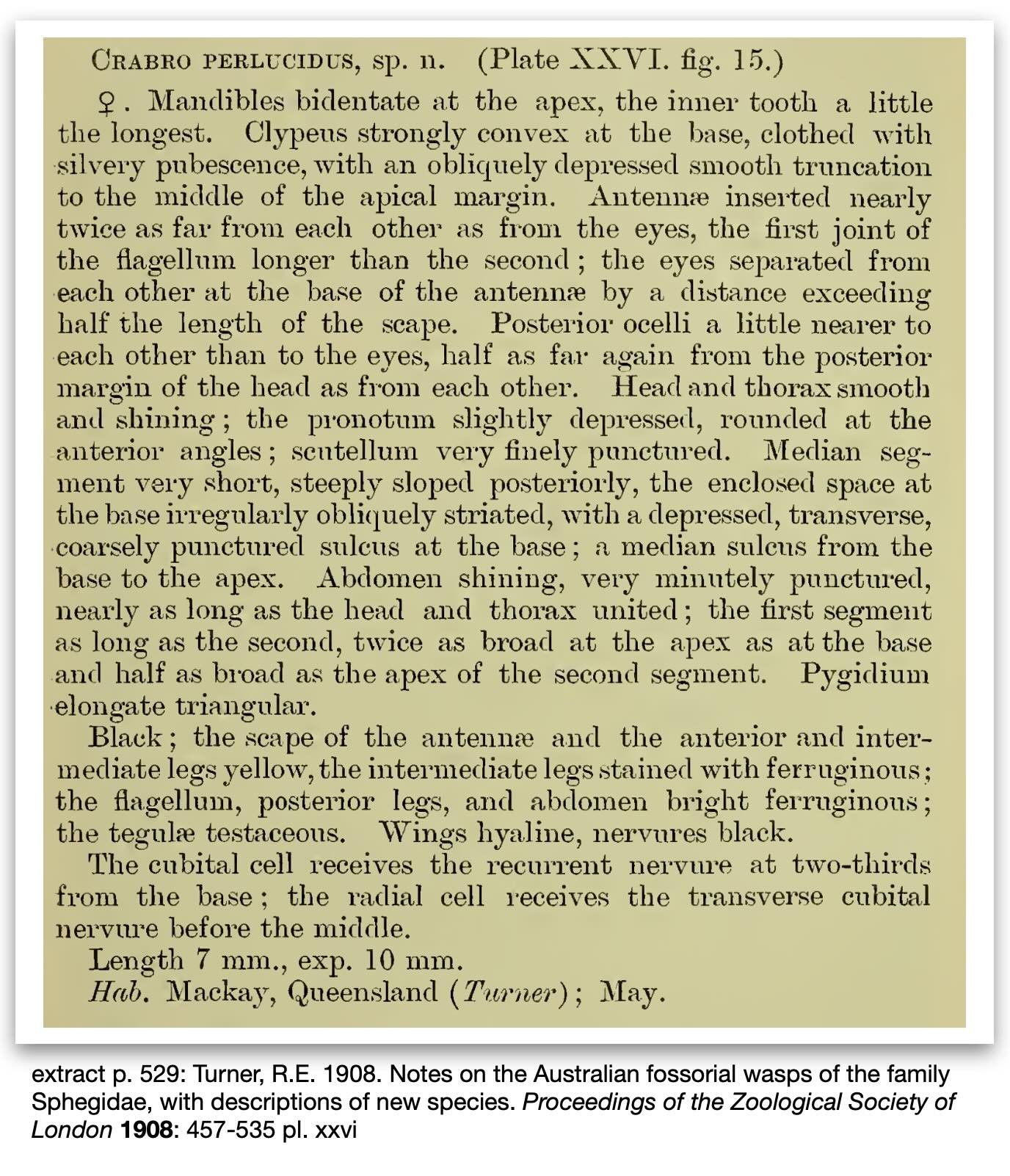
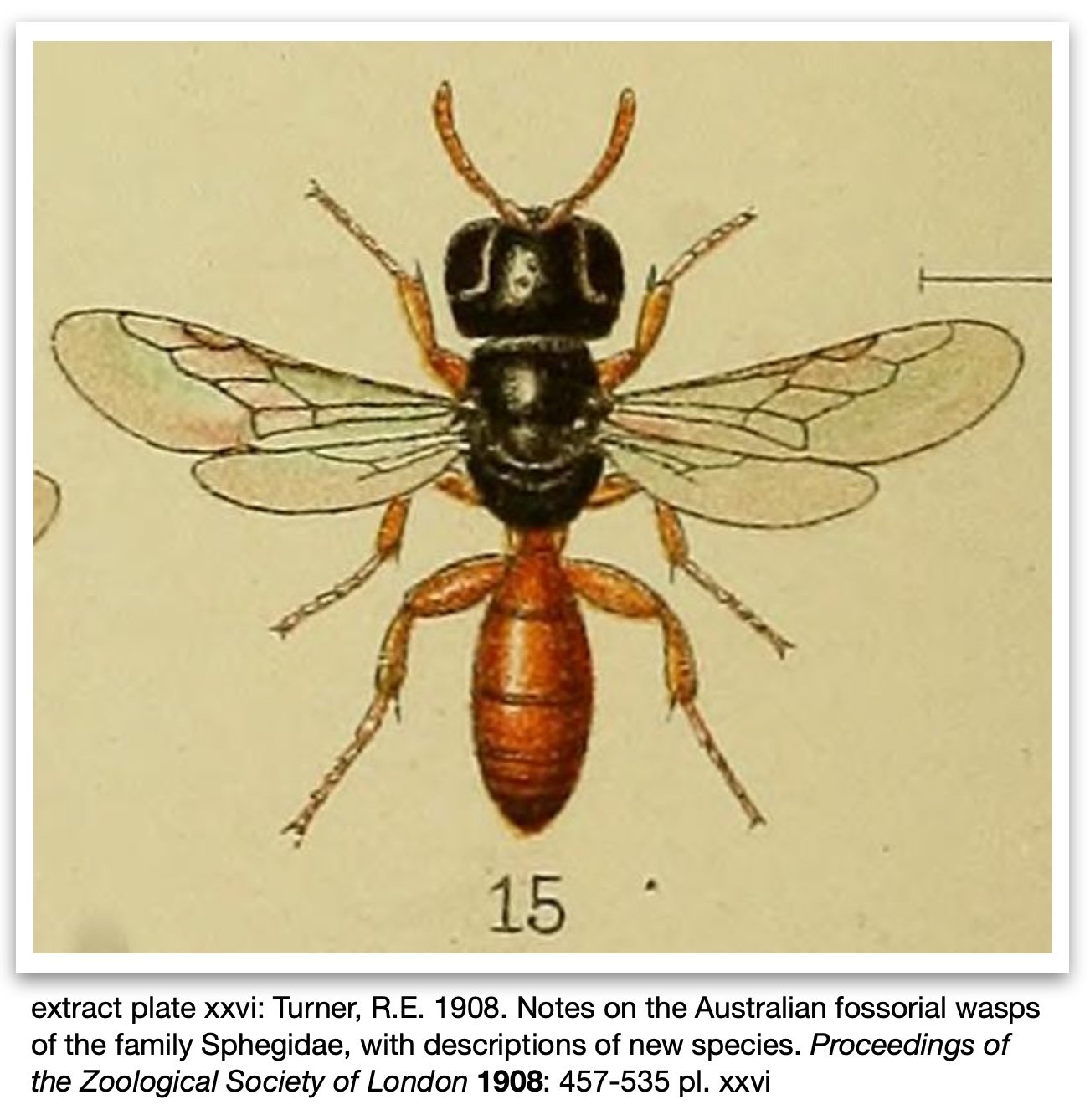
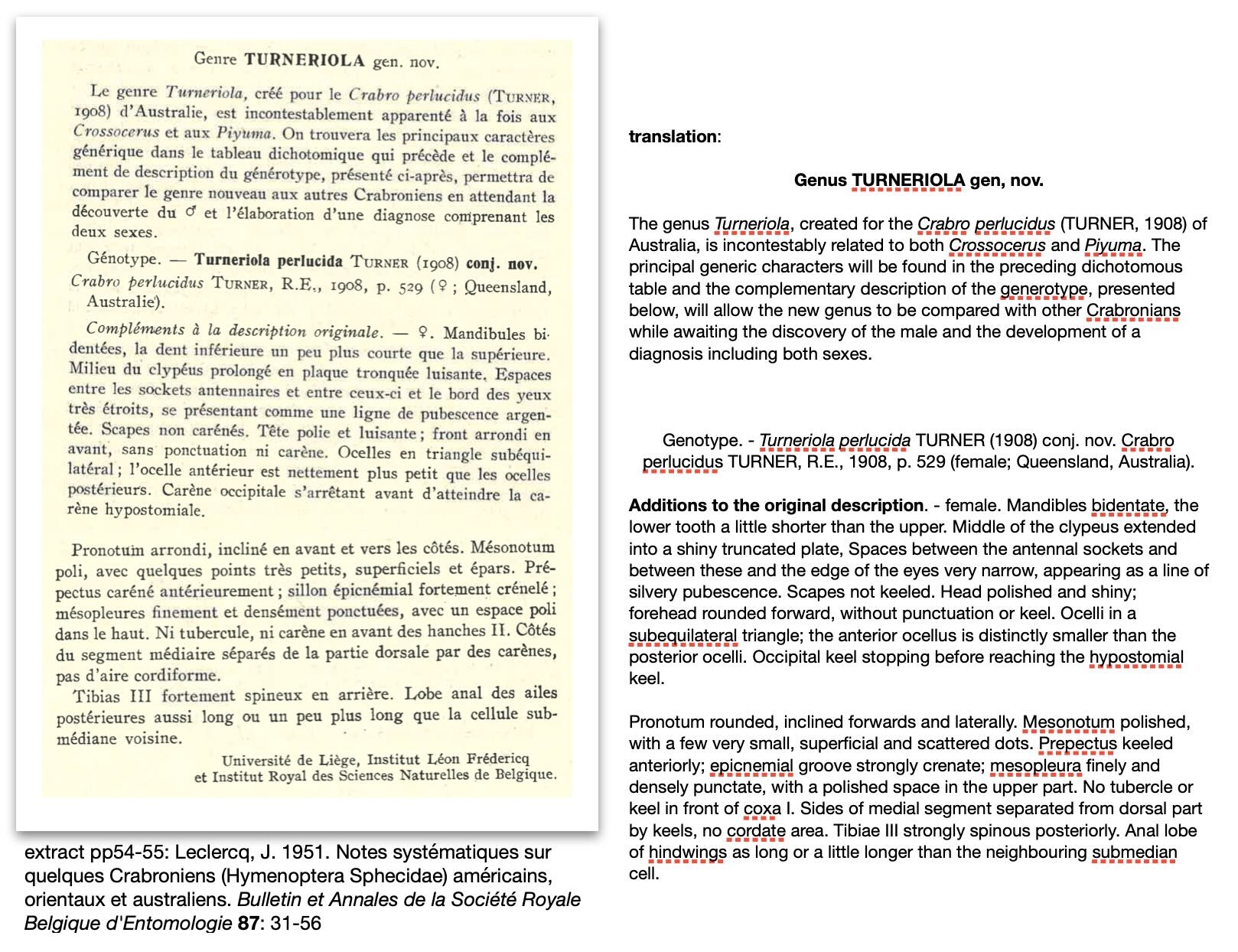

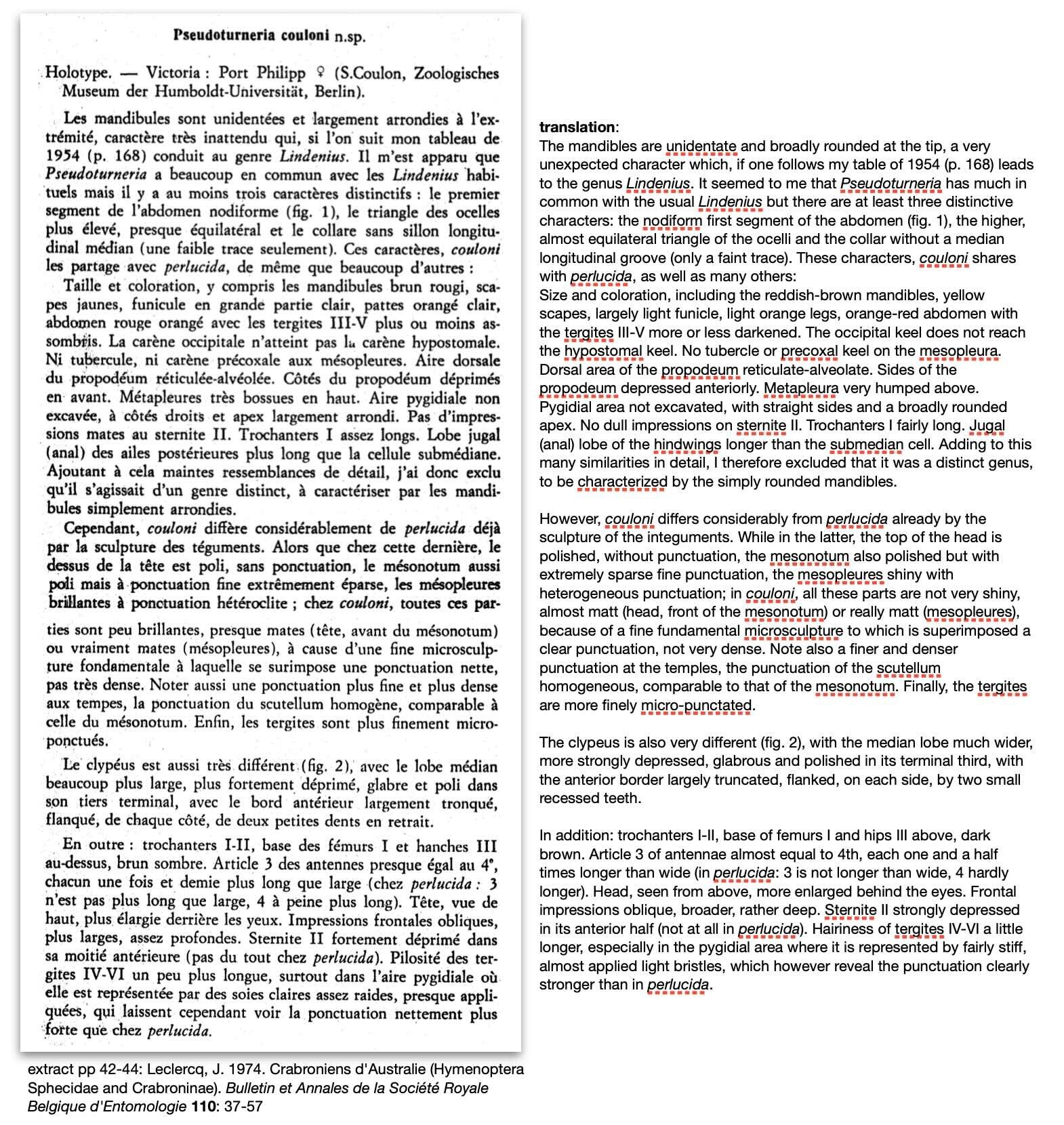
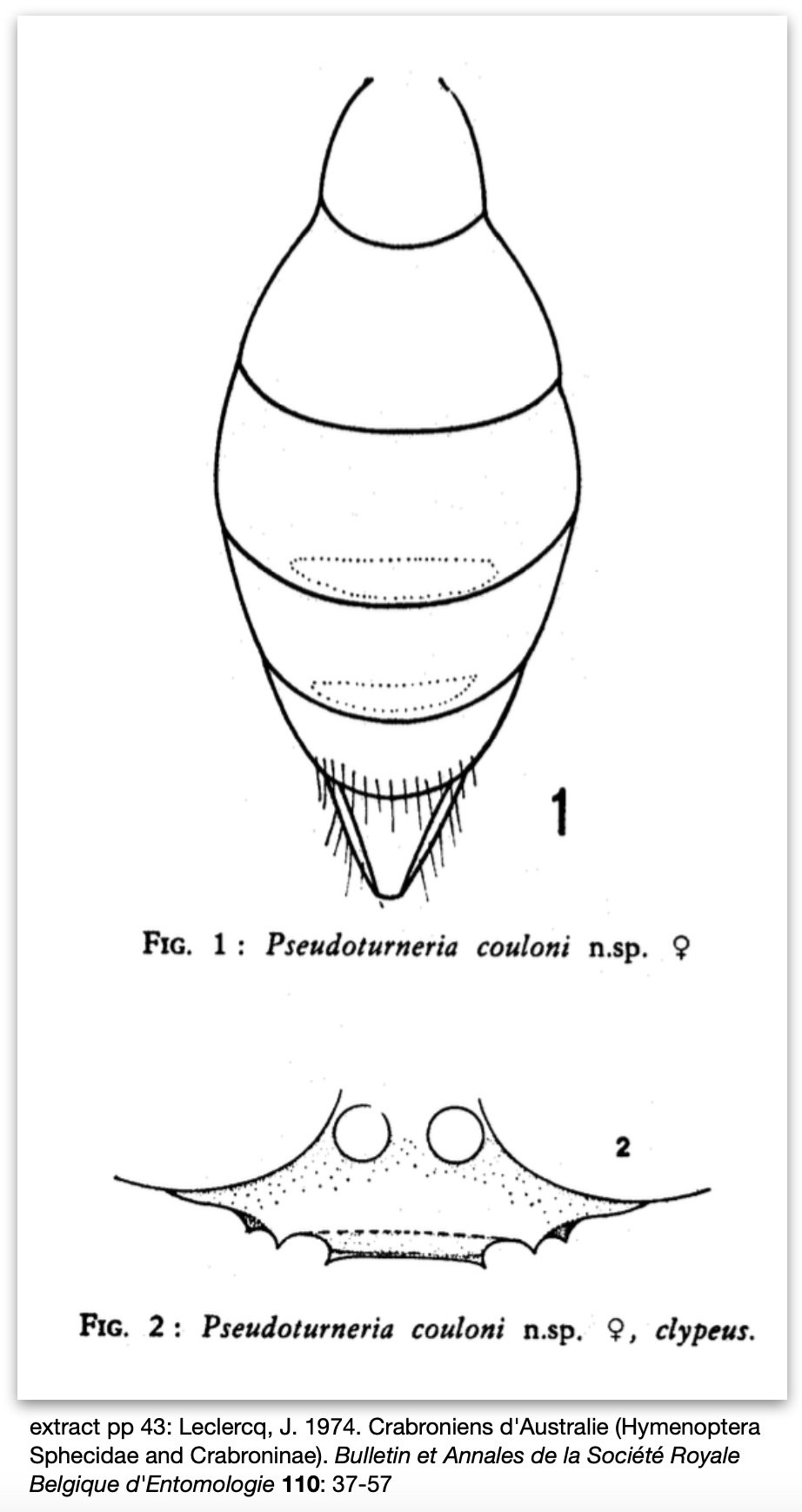


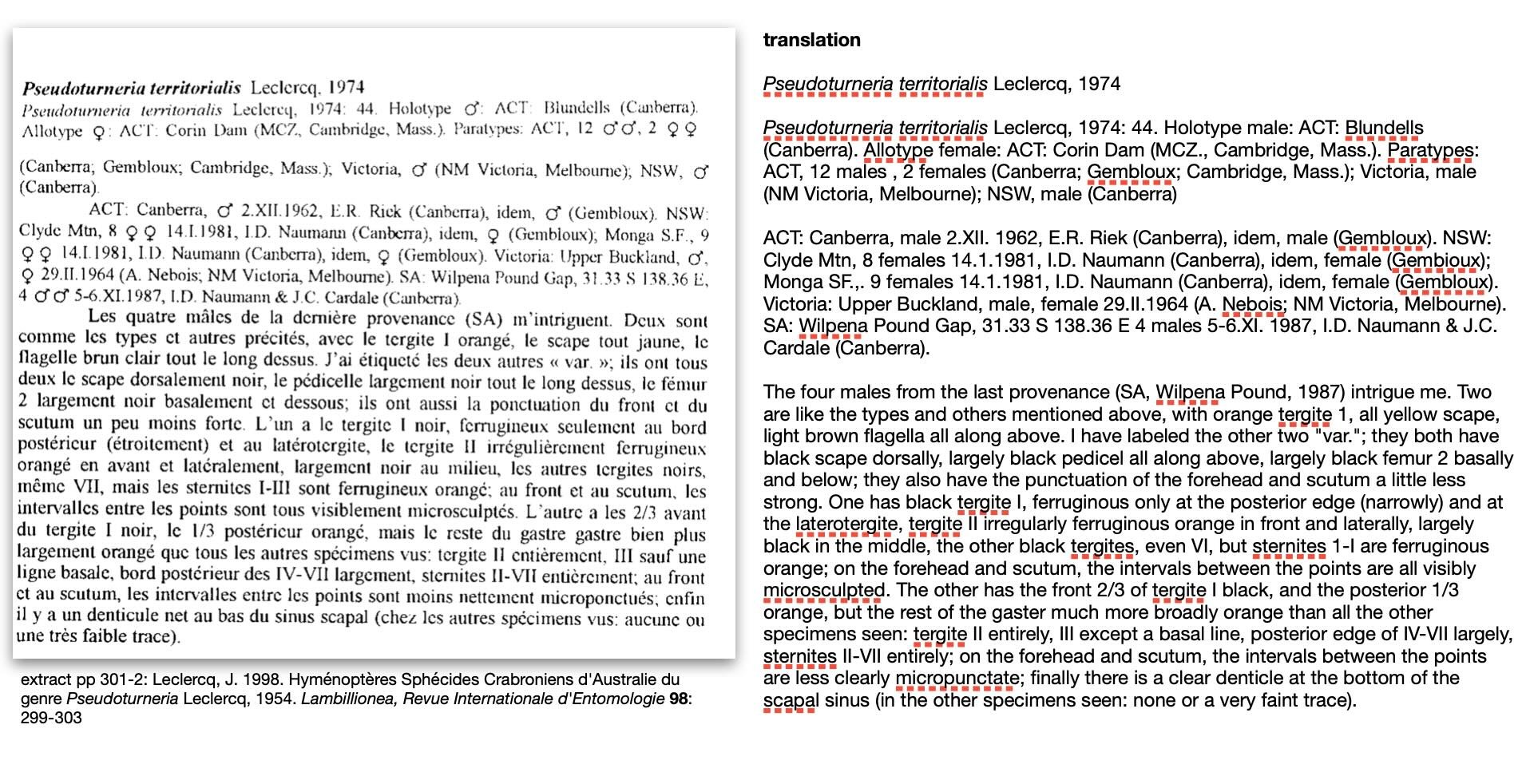
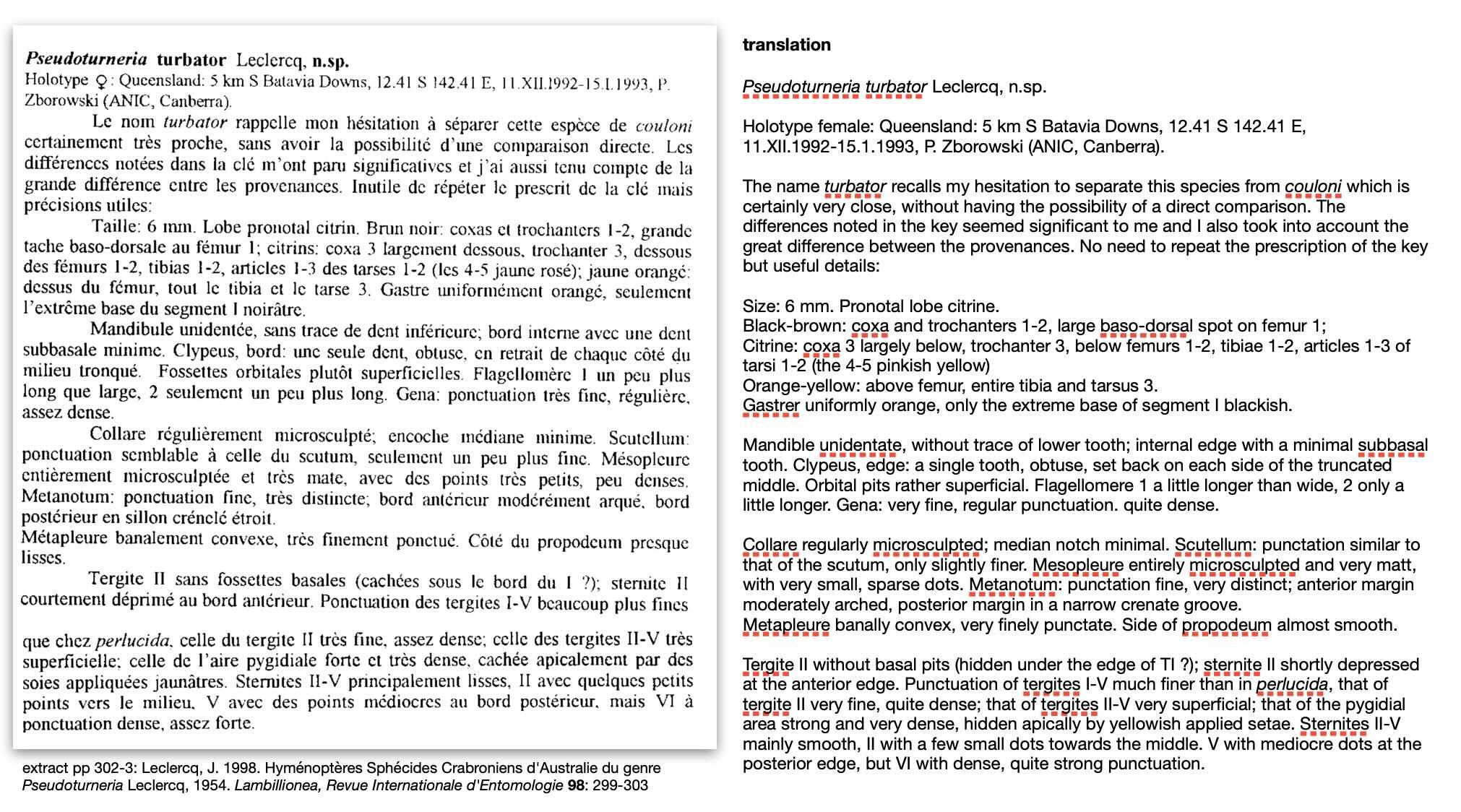
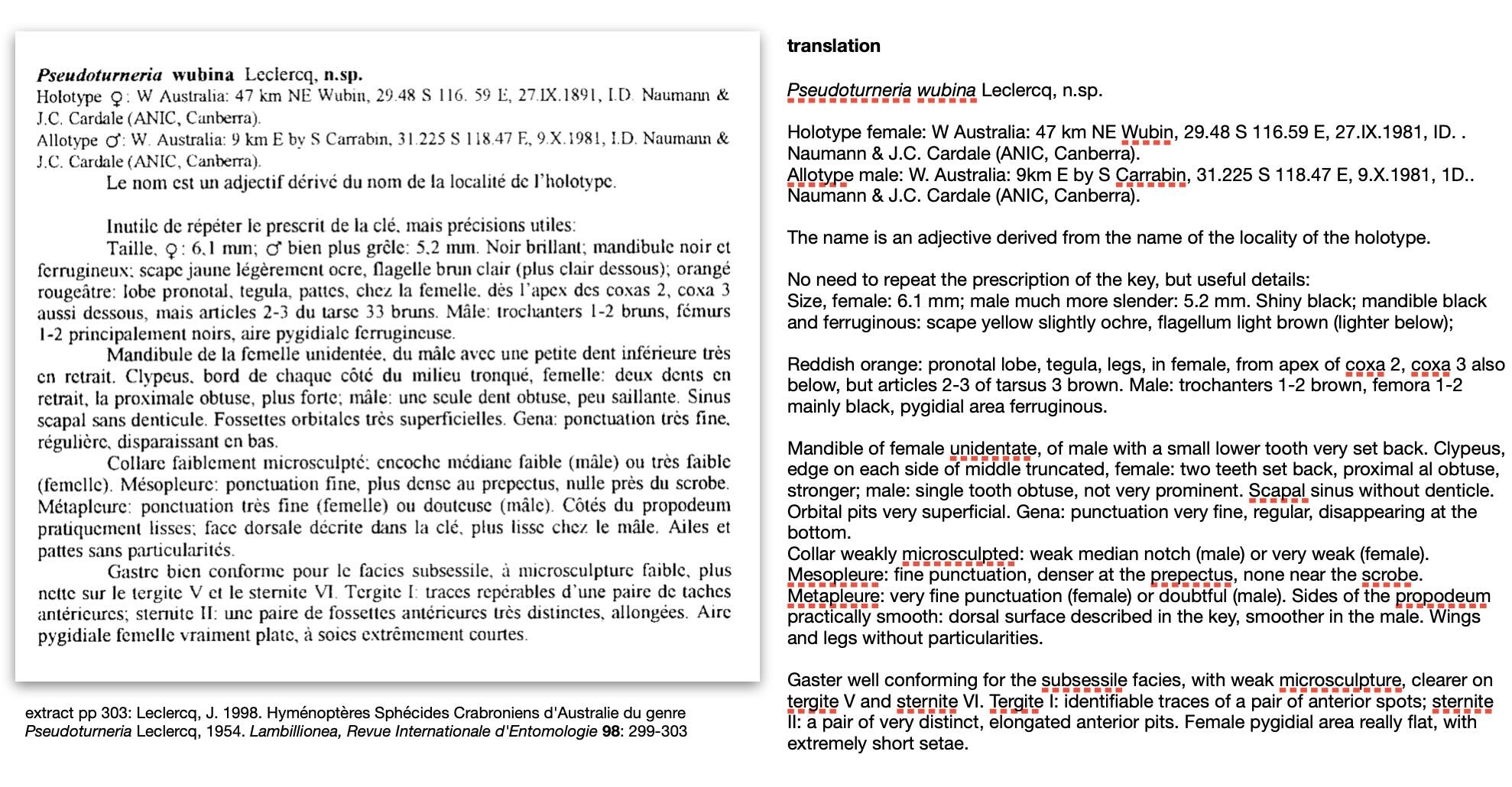
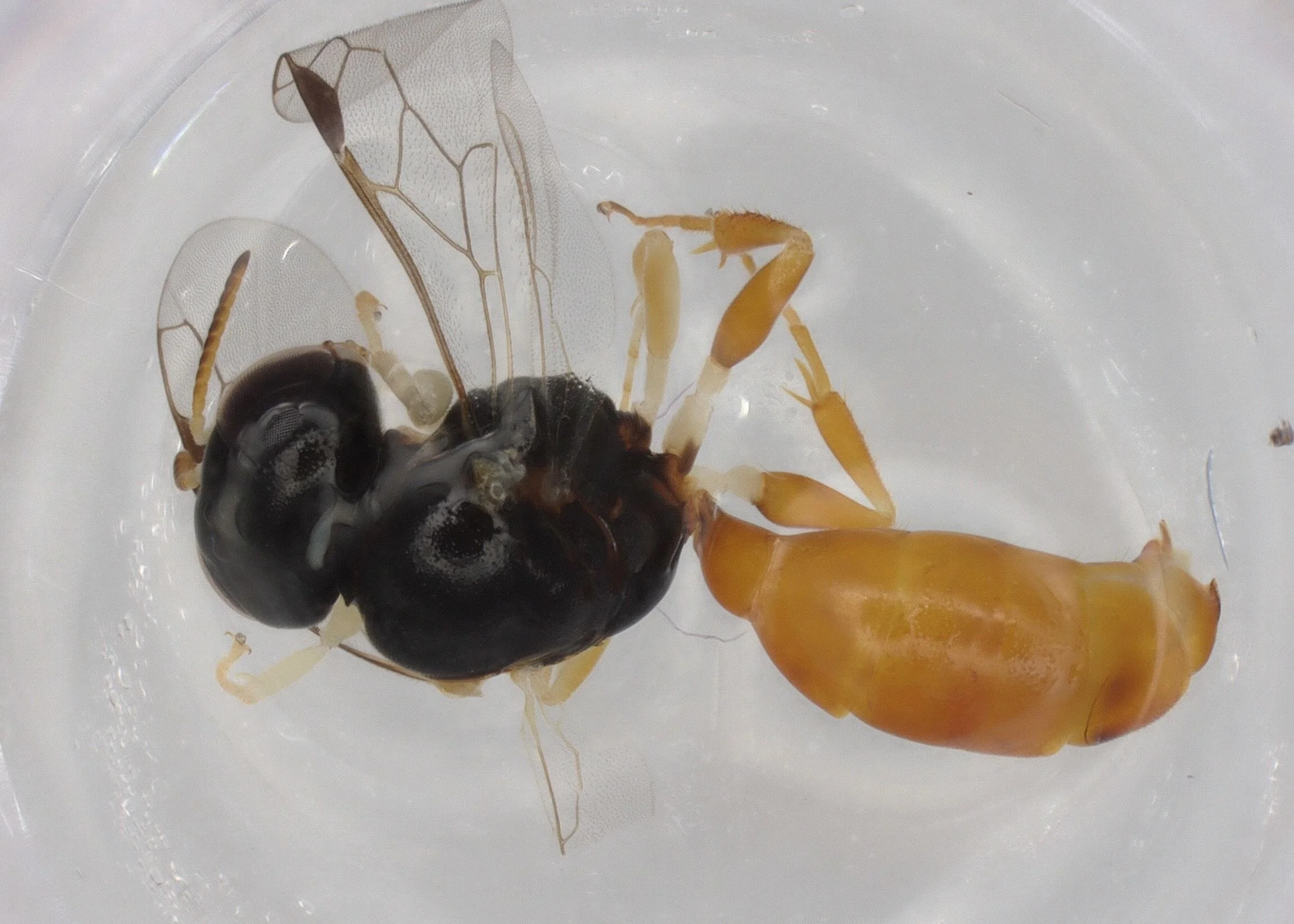
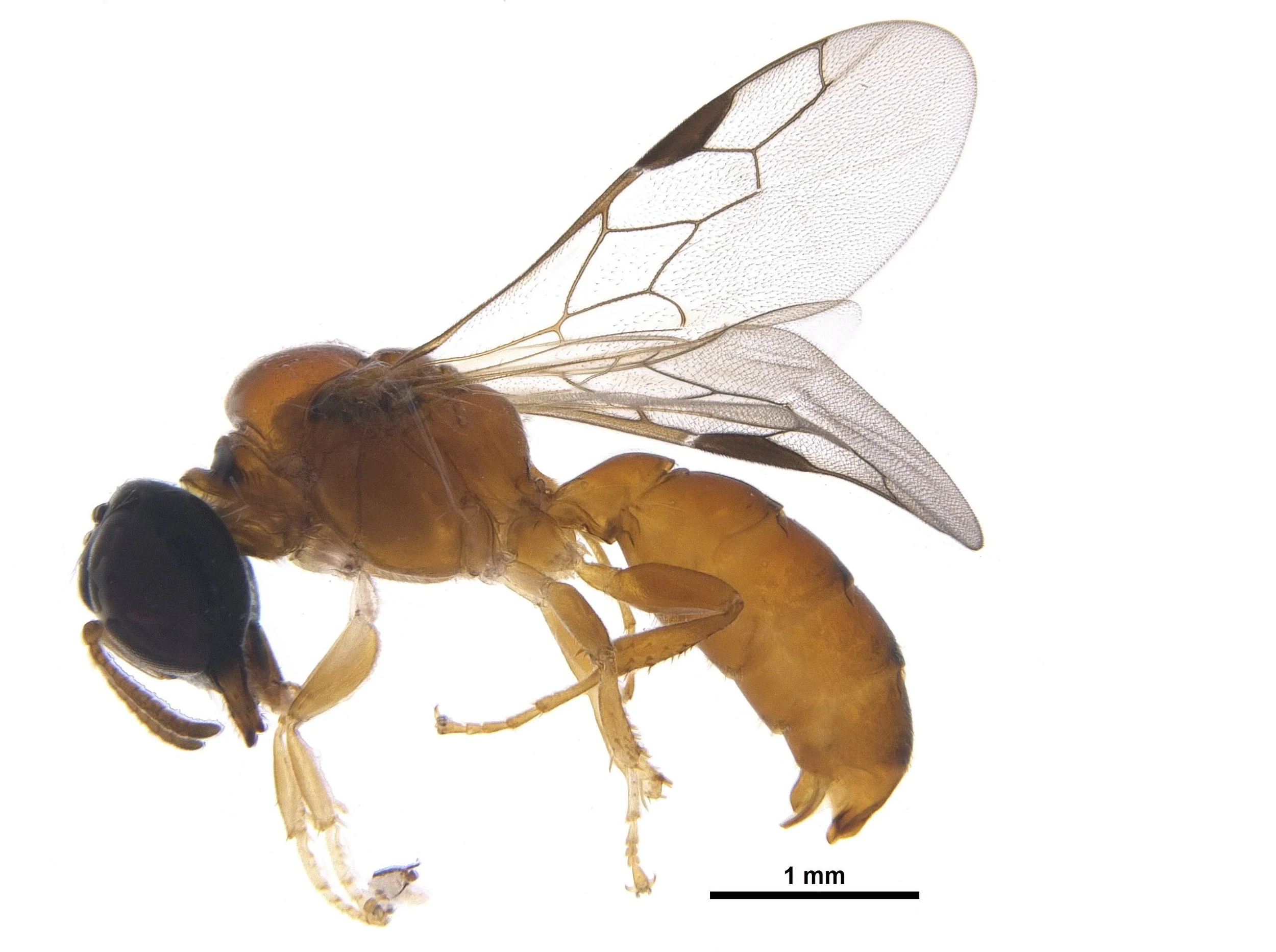
References
Leclercq, J. 1974. Crabroniens d'Australie (Hymenoptera Sphecidae and Crabroninae). Bulletin et Annales de la Société Royale Belgique d'Entomologie 110: 37-57
Leclercq, J. 1998. Hyménoptères Sphécides Crabroniens d'Australie du genre Pseudoturneria Leclercq, 1954. Lambillionea, Revue Internationale d'Entomologie 98: 299-303 …open access via Wikispecies
Turner, R.E. 1908. Notes on the Australian fossorial wasps of the family Sphegidae, with descriptions of new species. Proceedings of the Zoological Society of London 1908: 457-535 pl. xxvi
This is a workbook page … a part of our website where we record the observations and references used in making species identifications. The notes will not necessarily be complete. They are a record for our own use, but we are happy to share this information with others.
